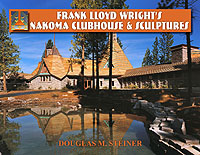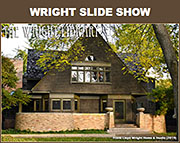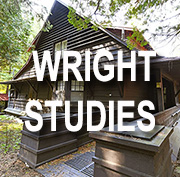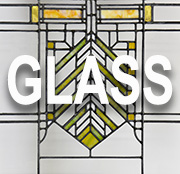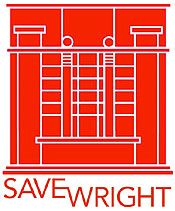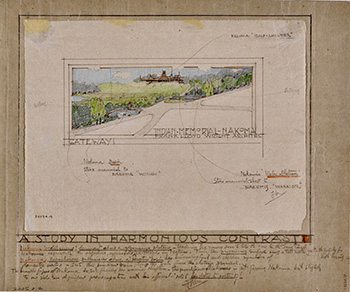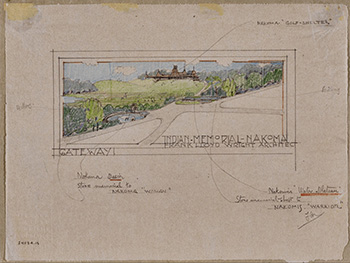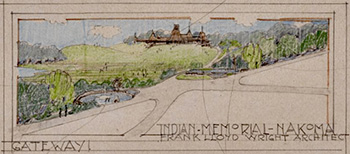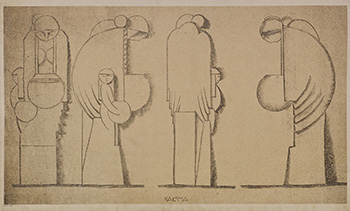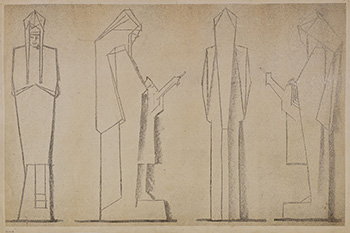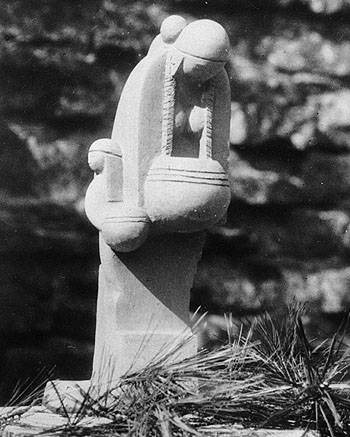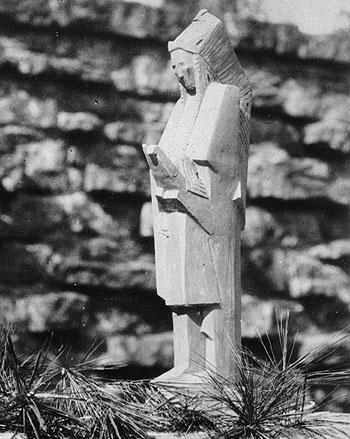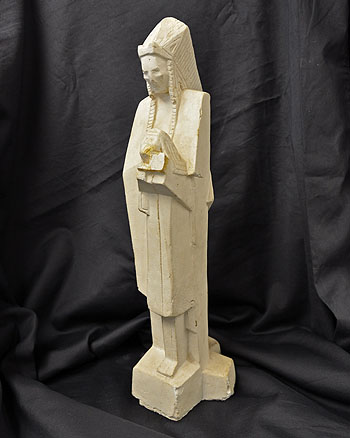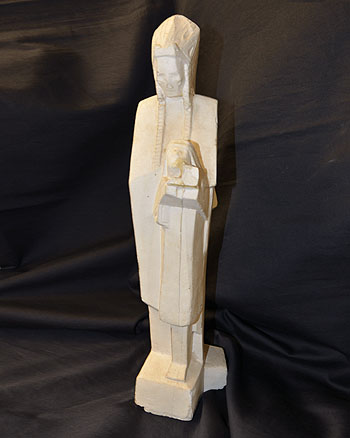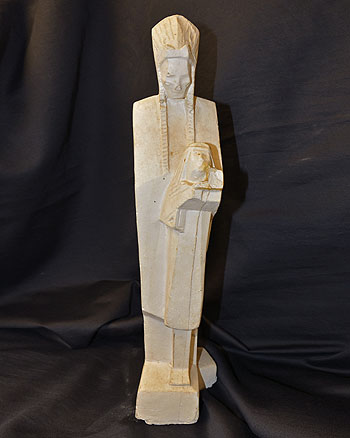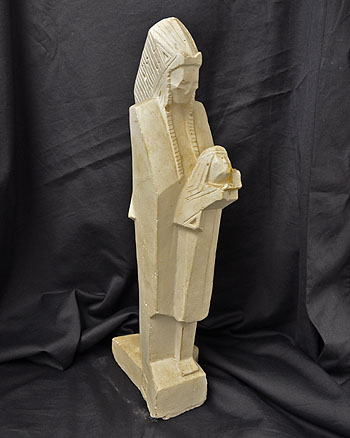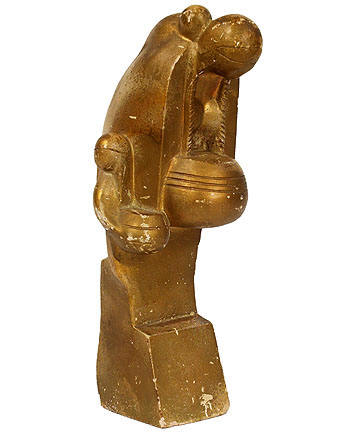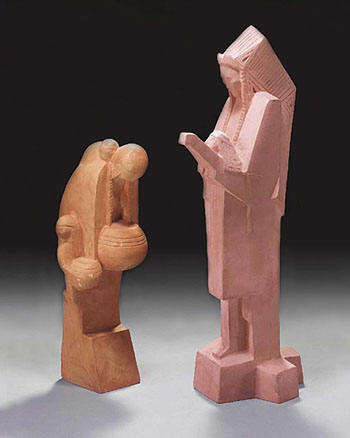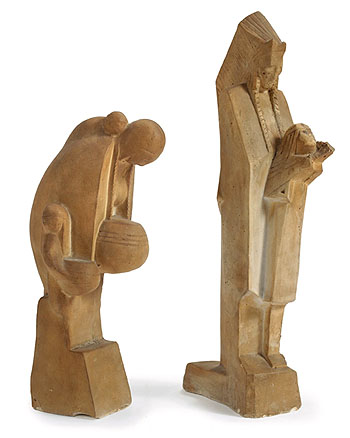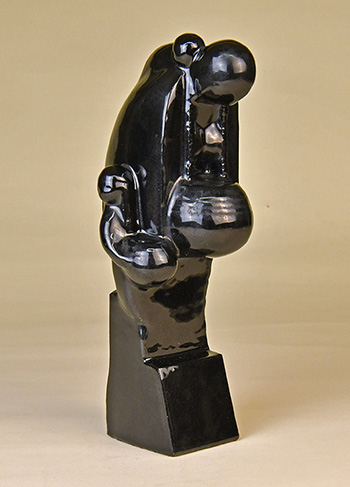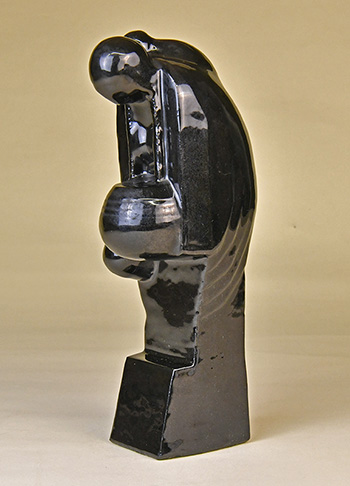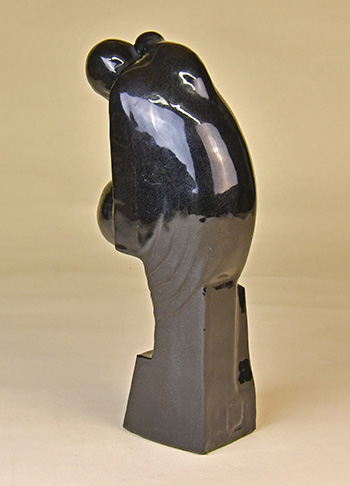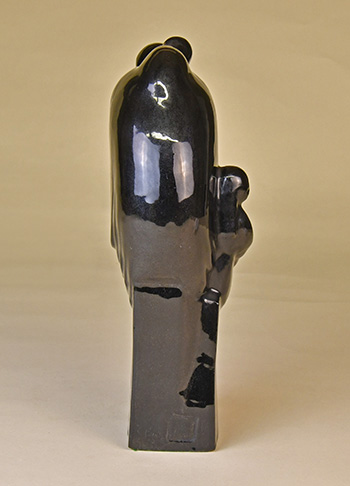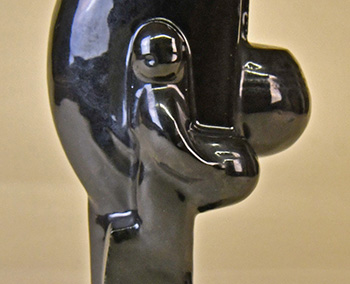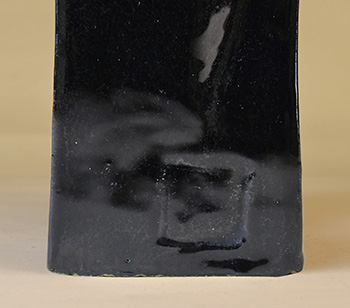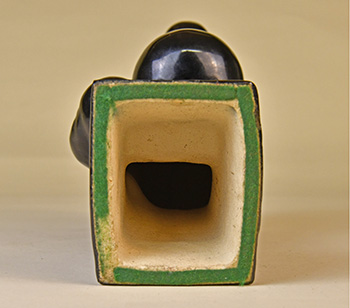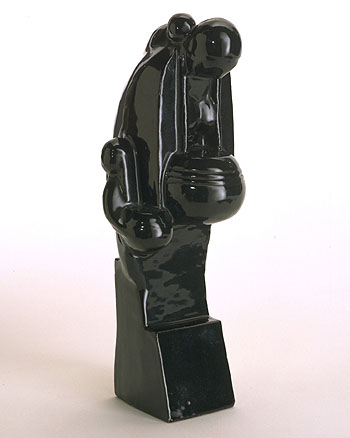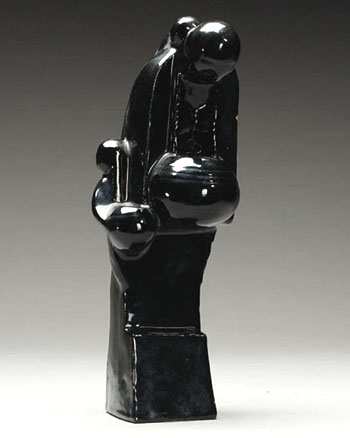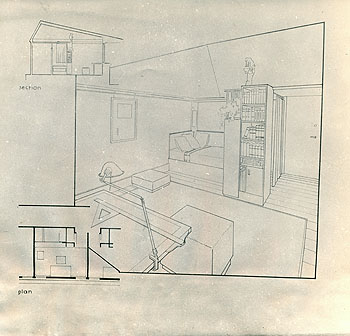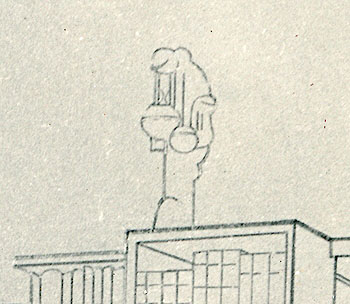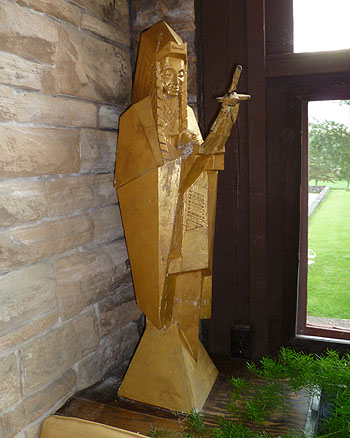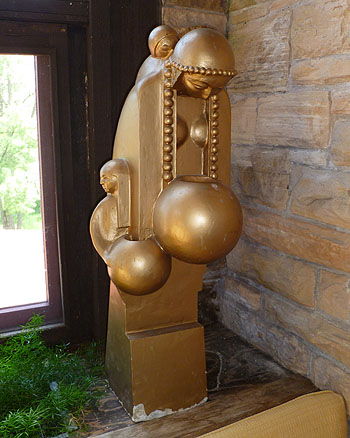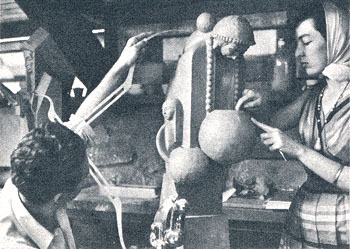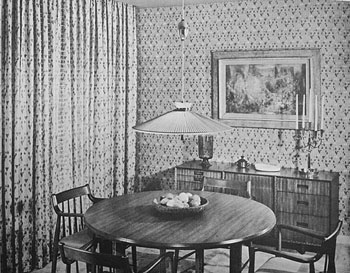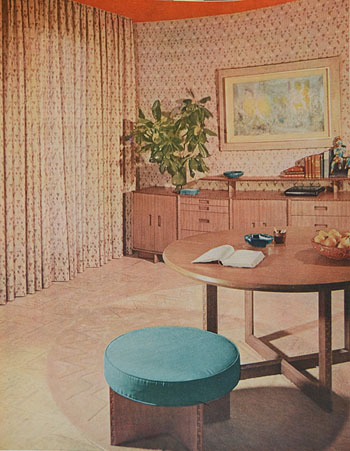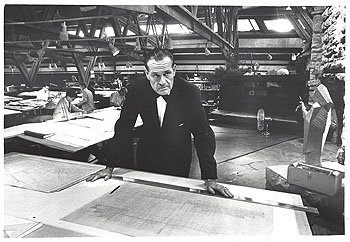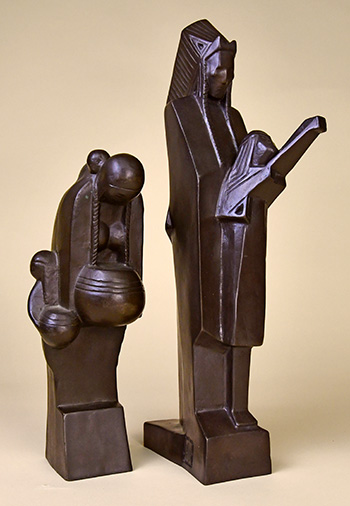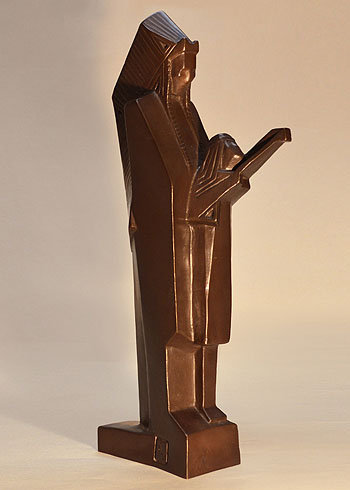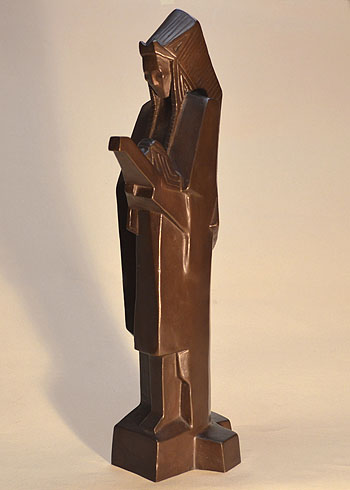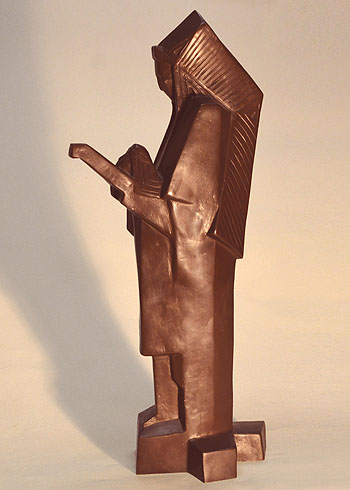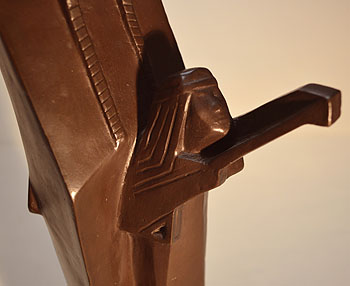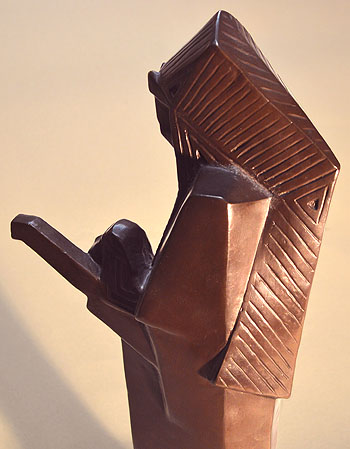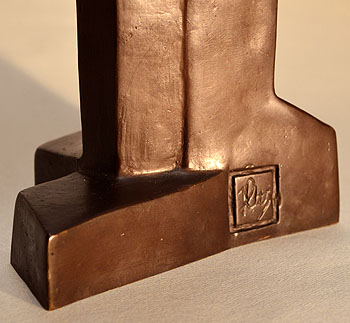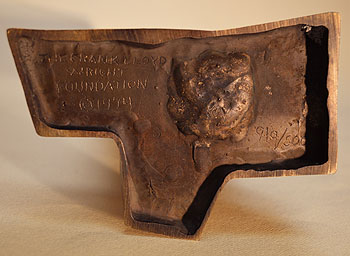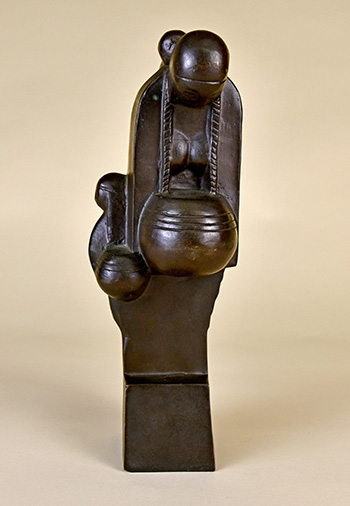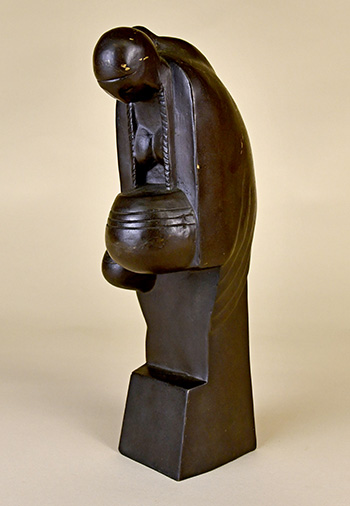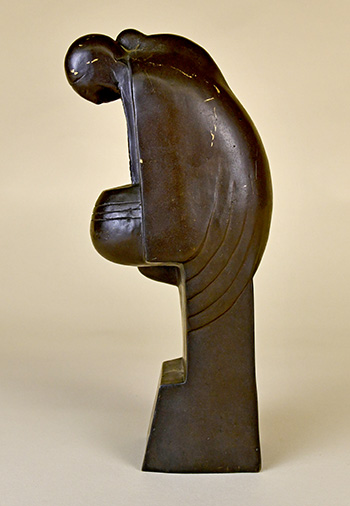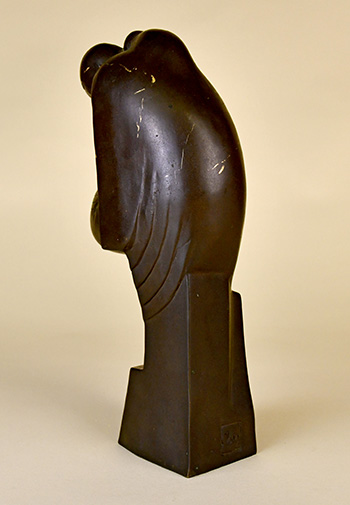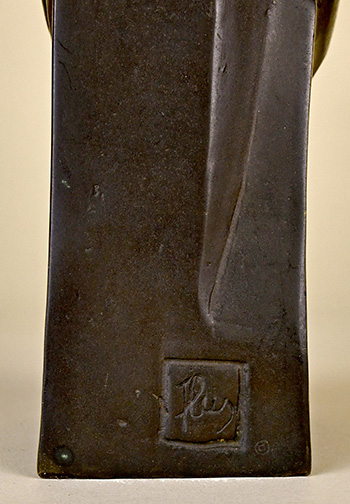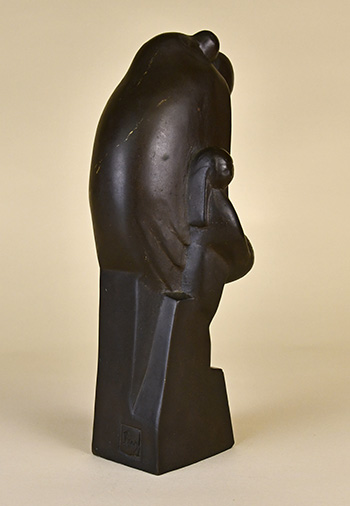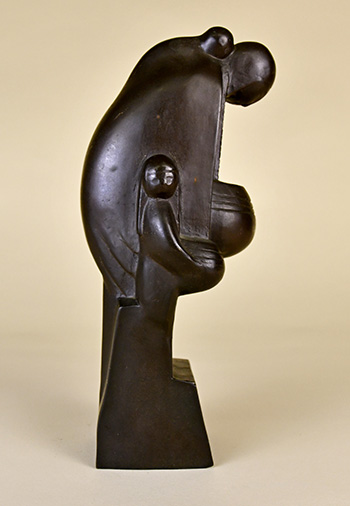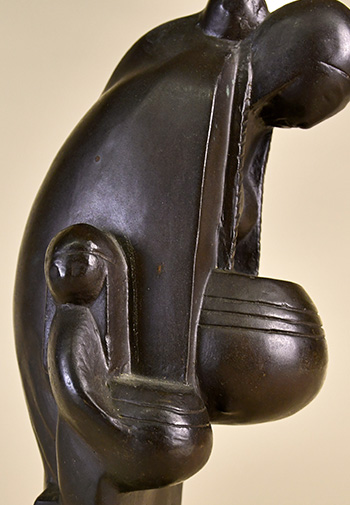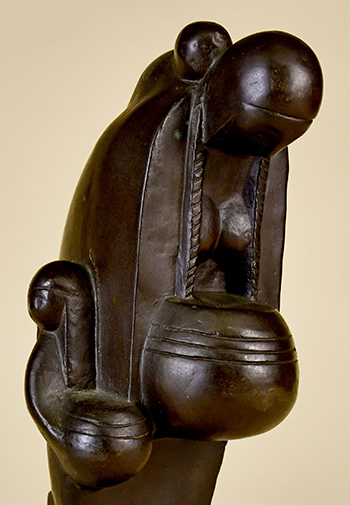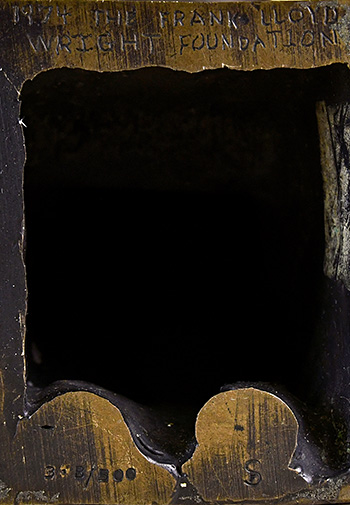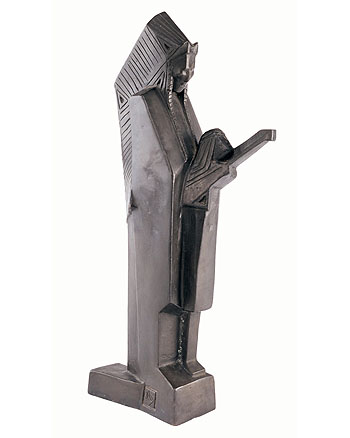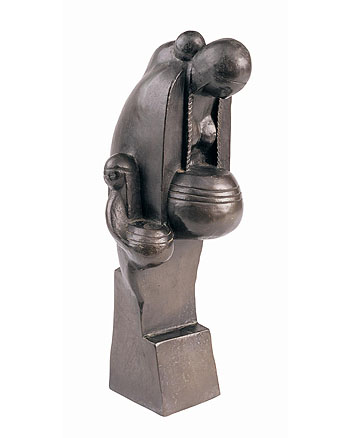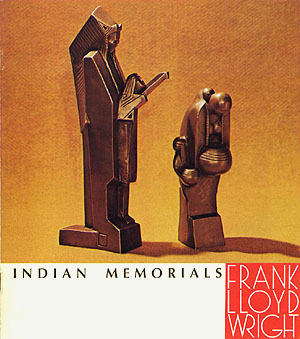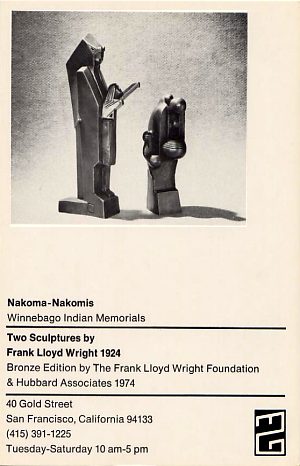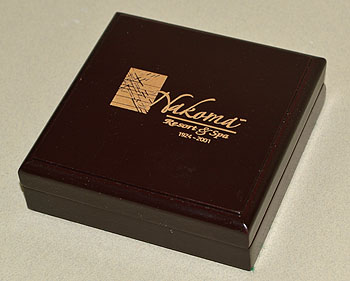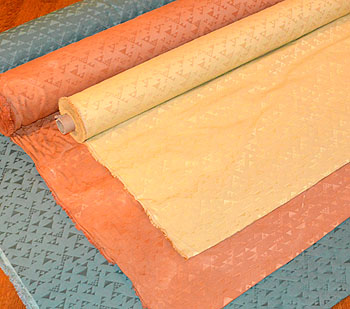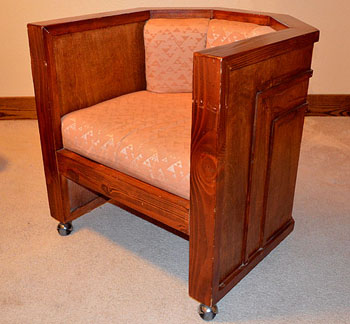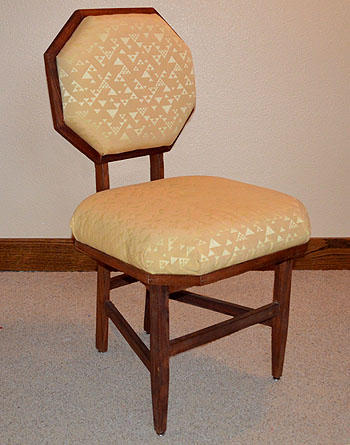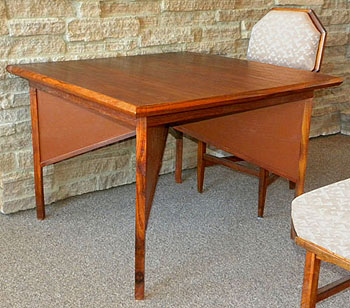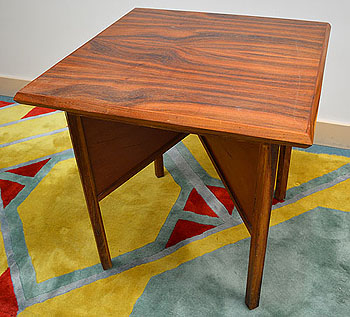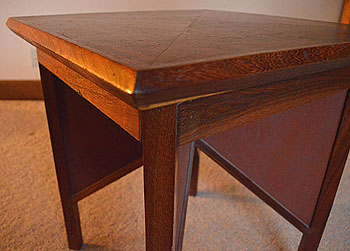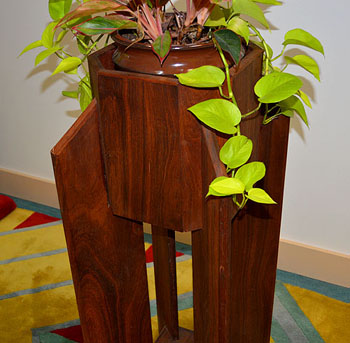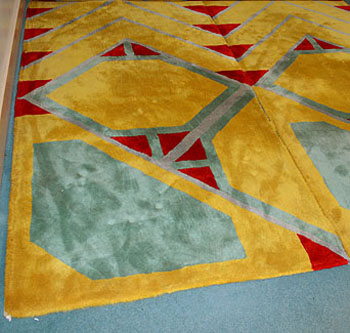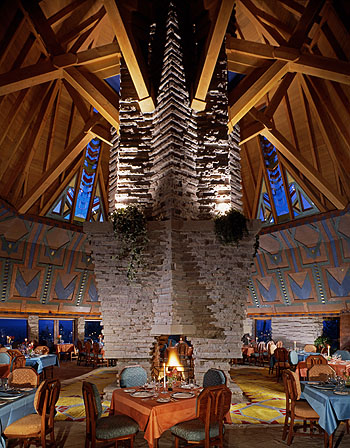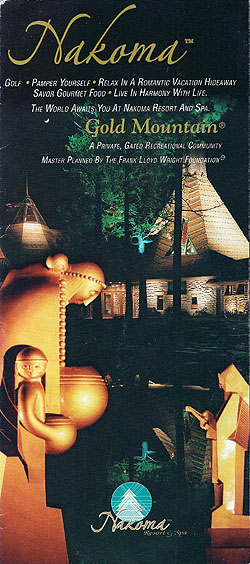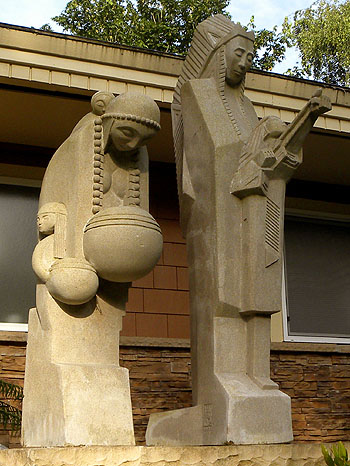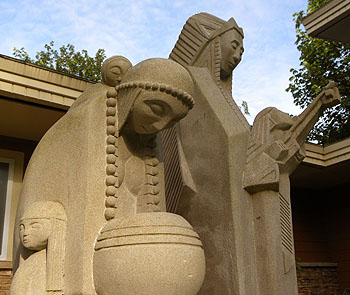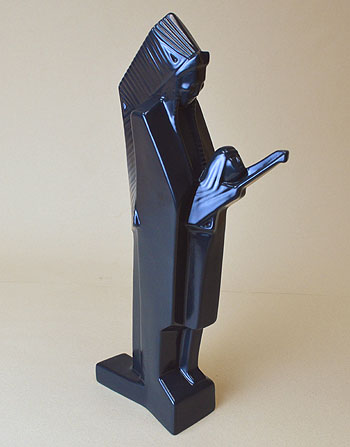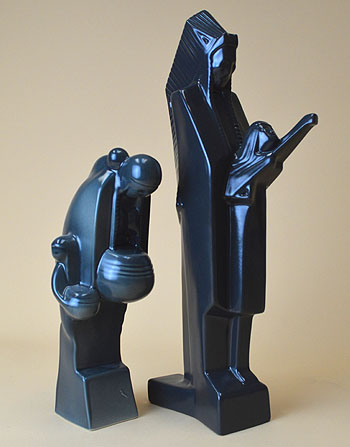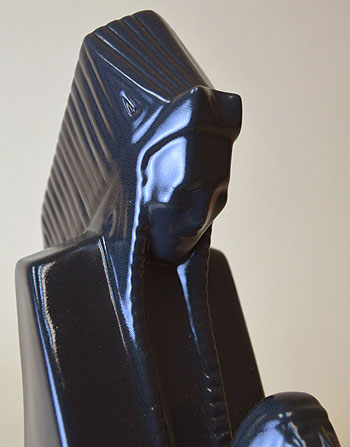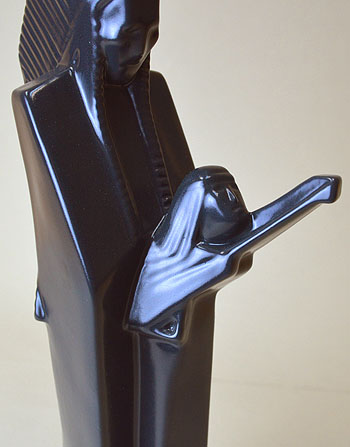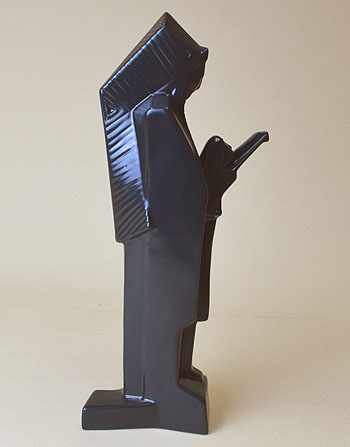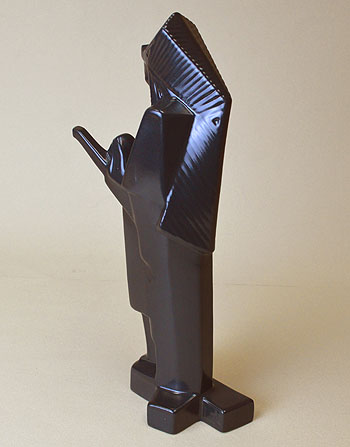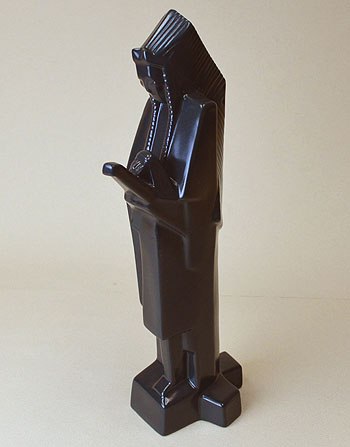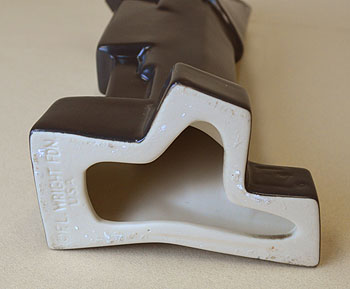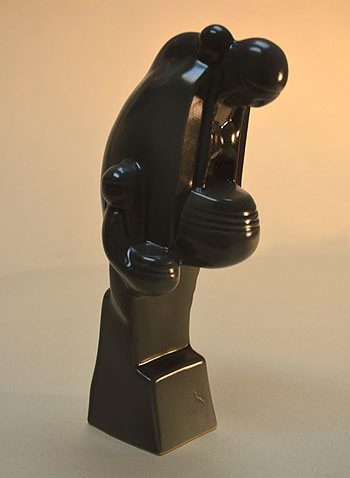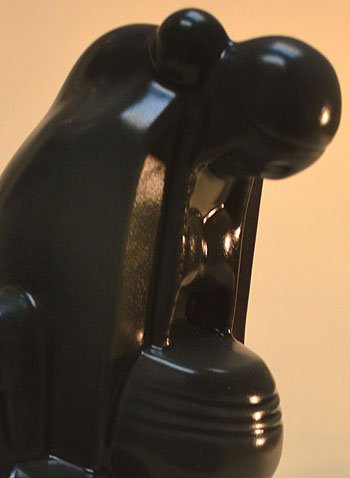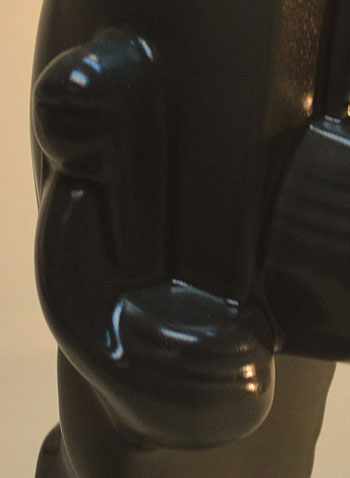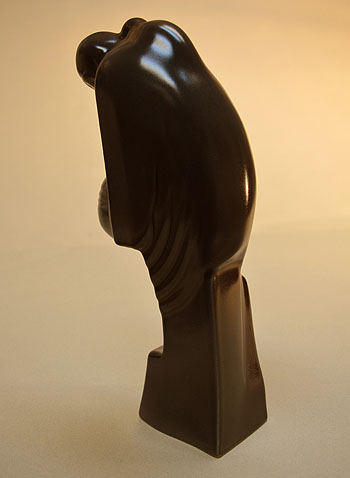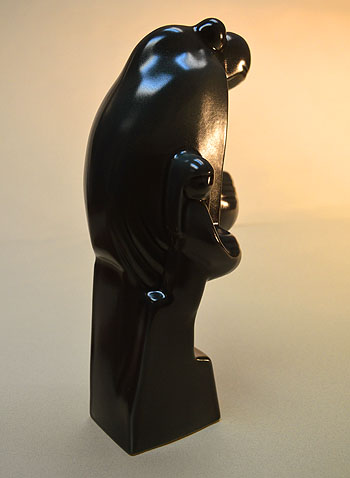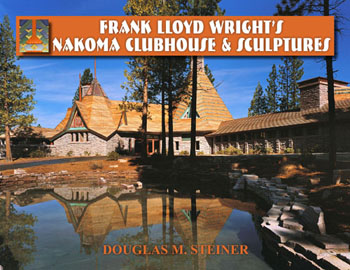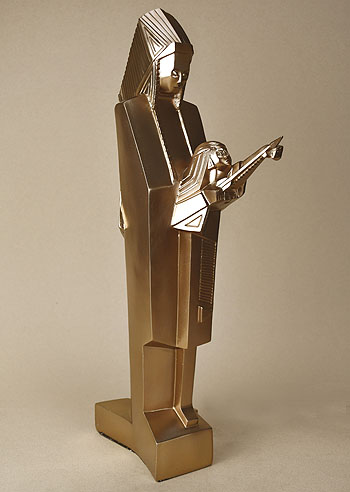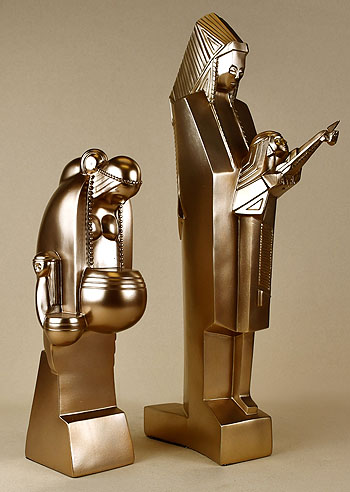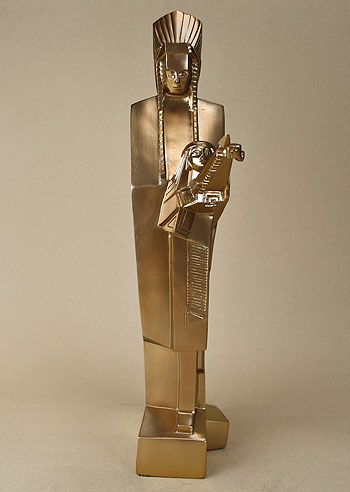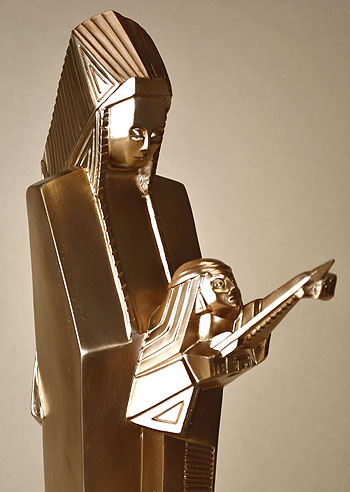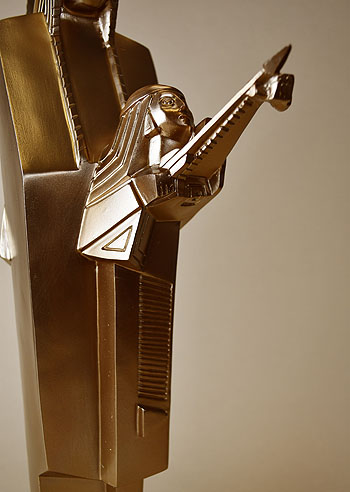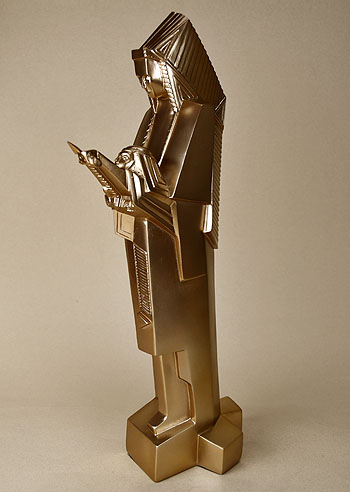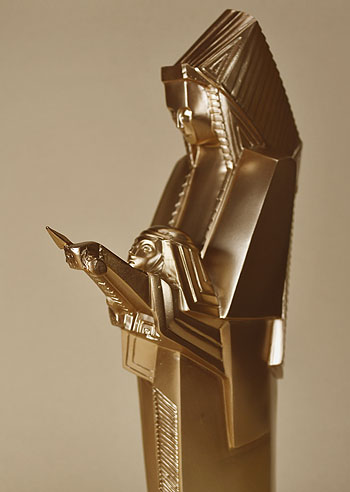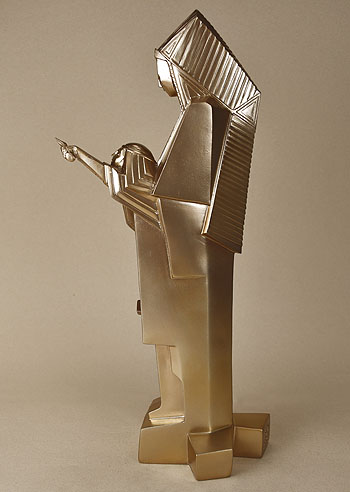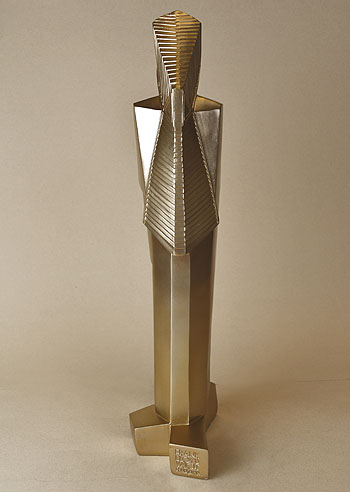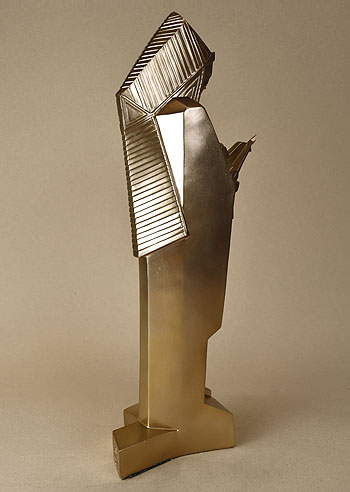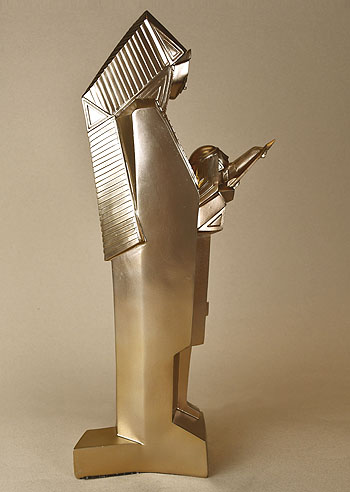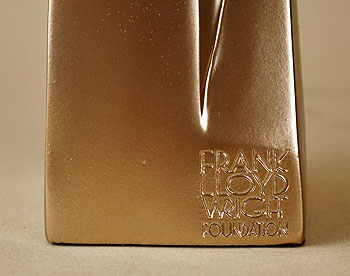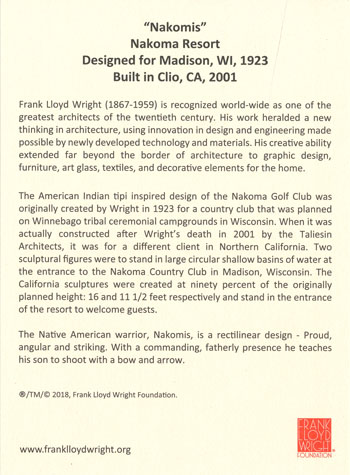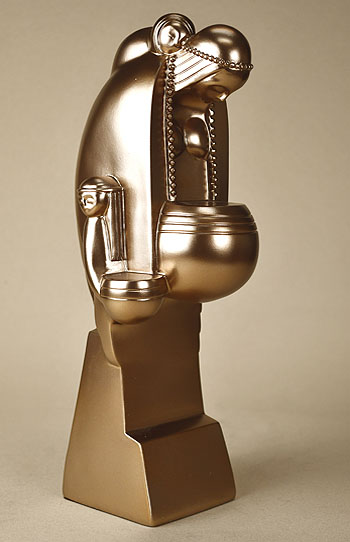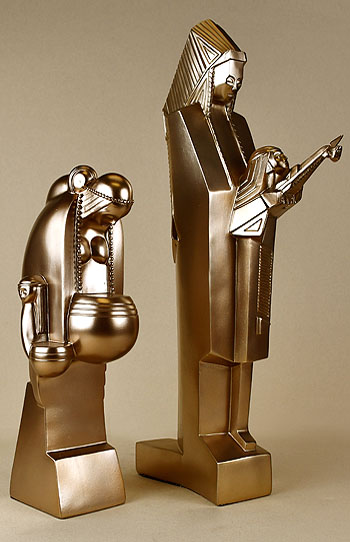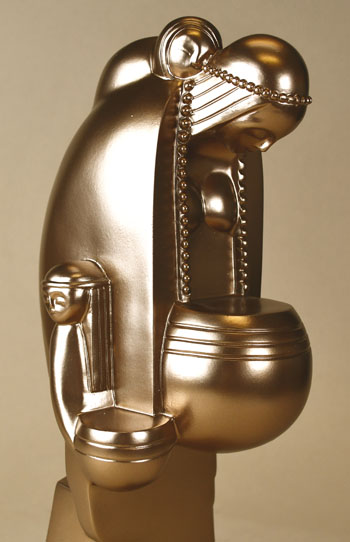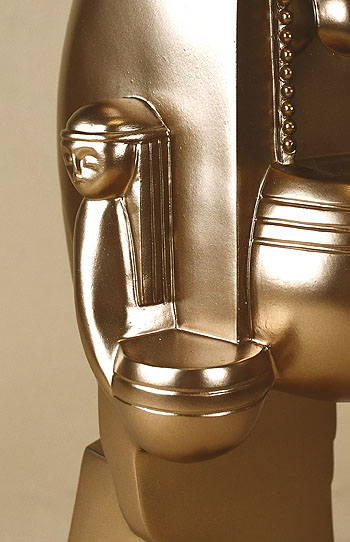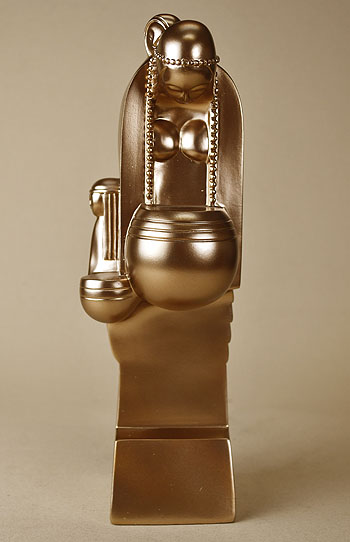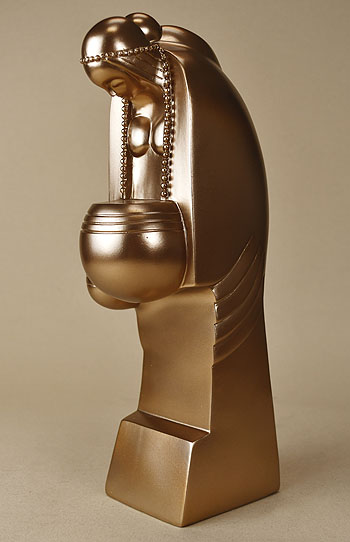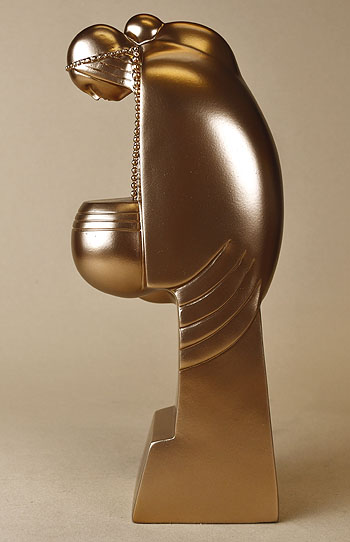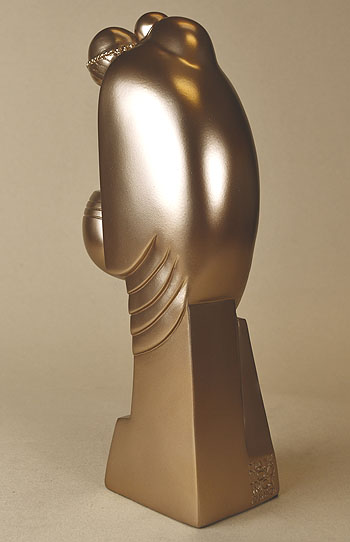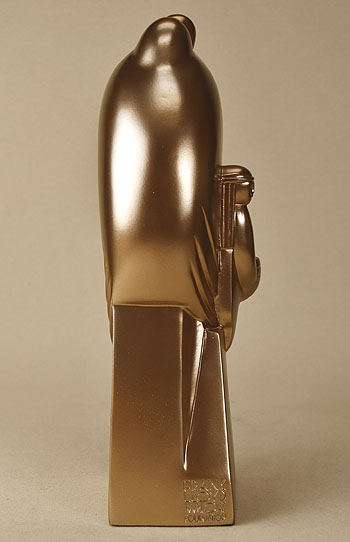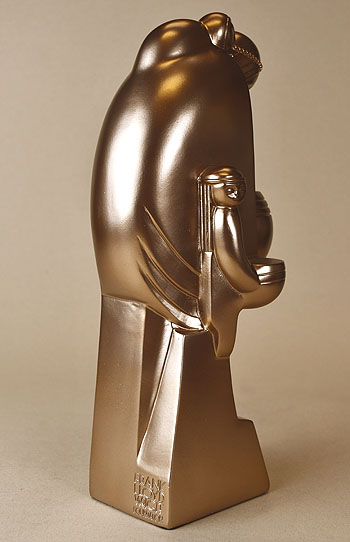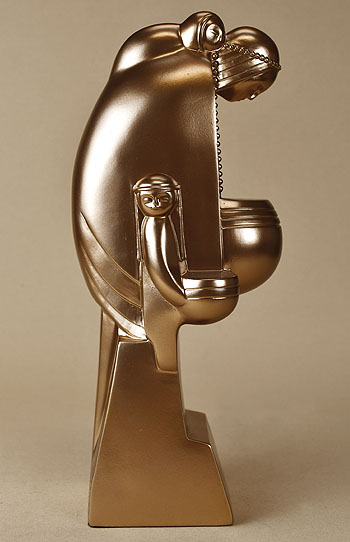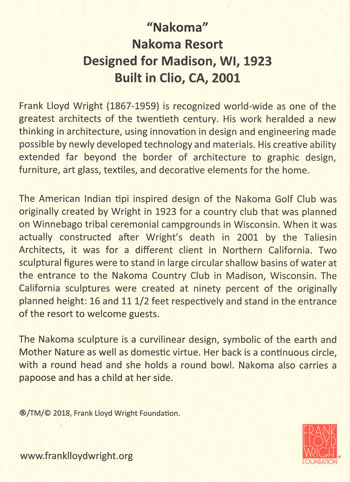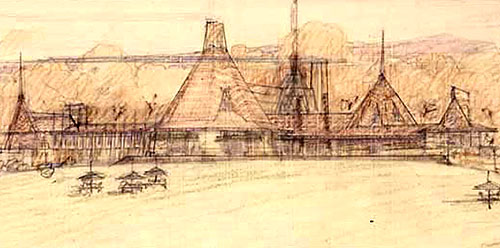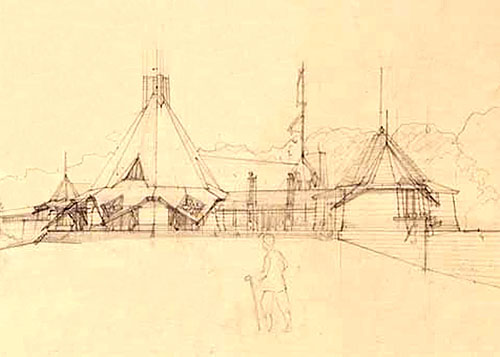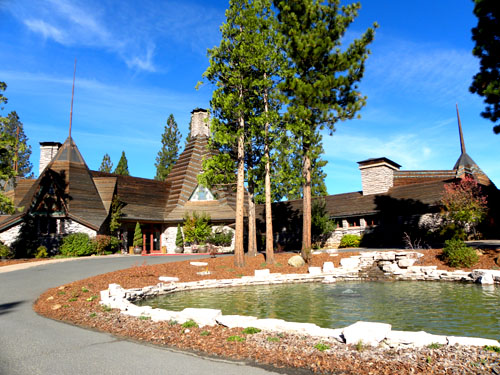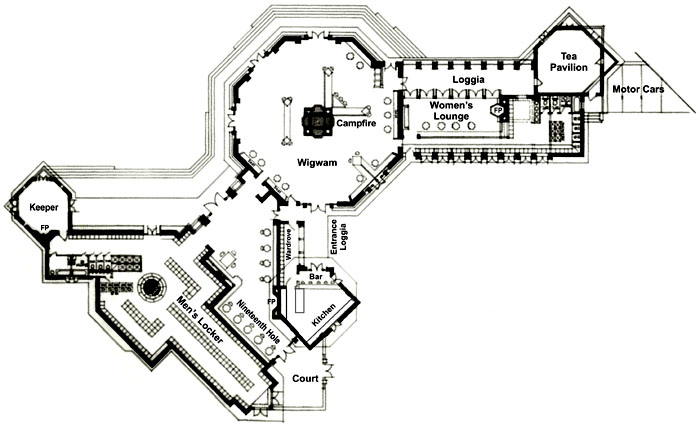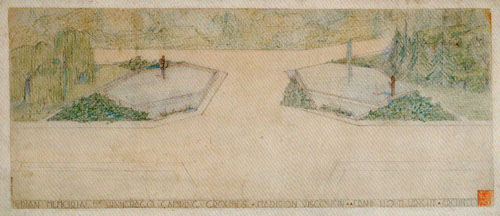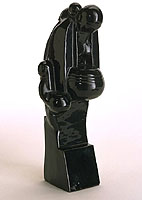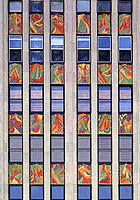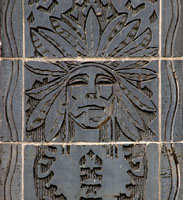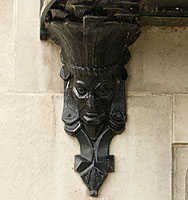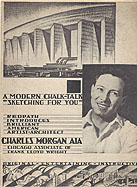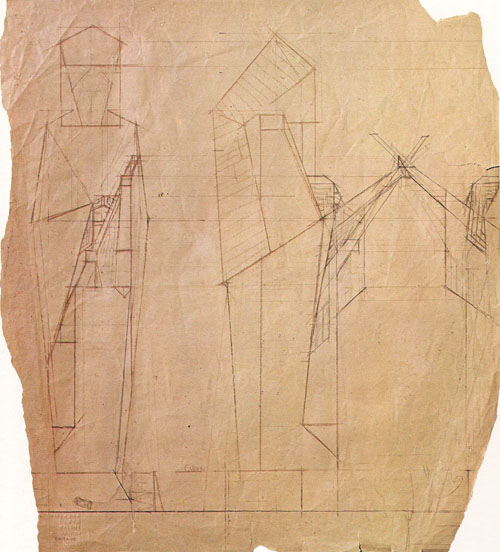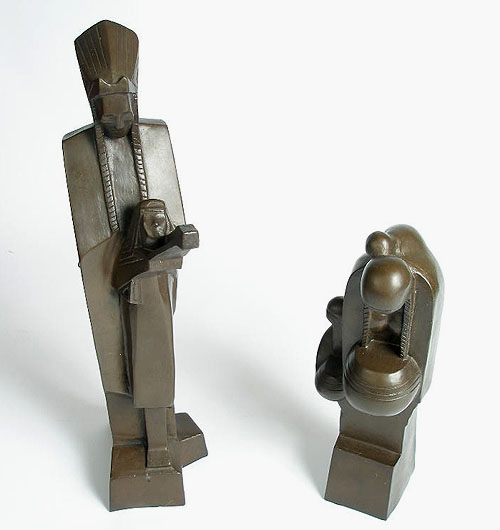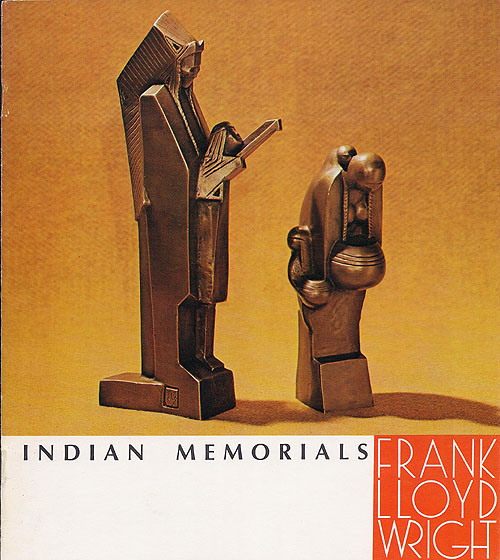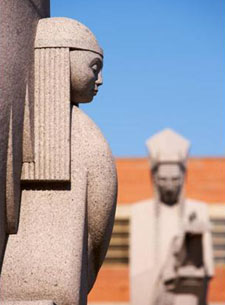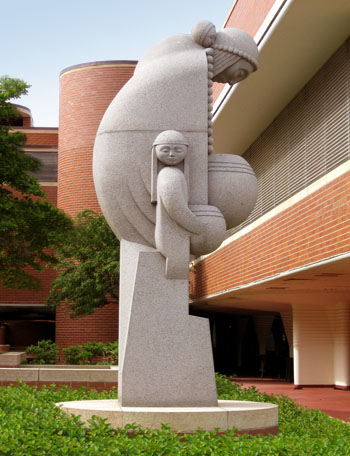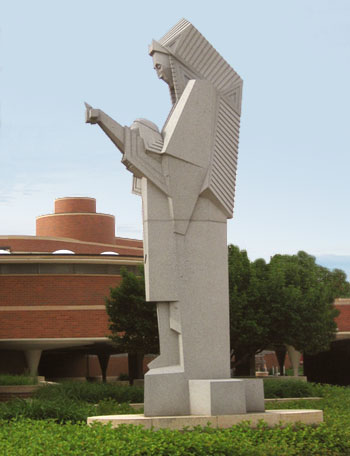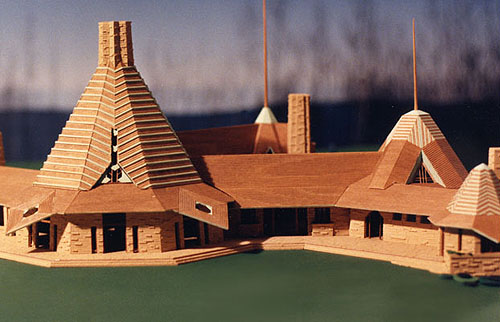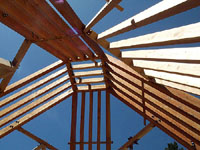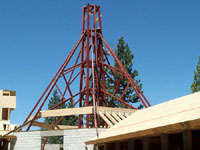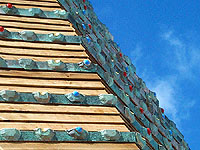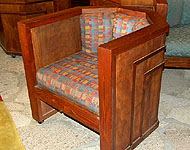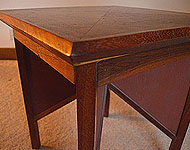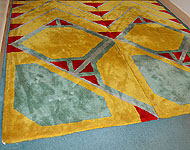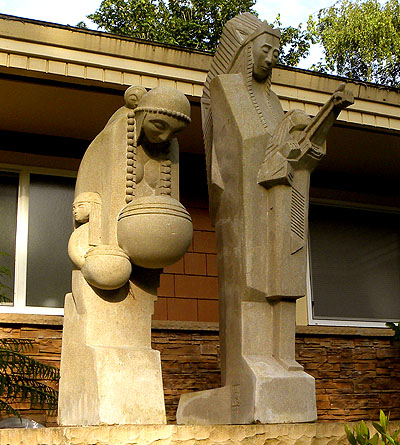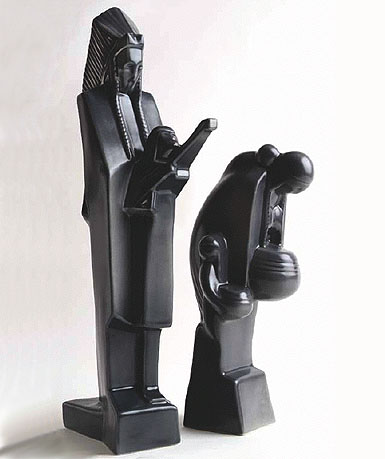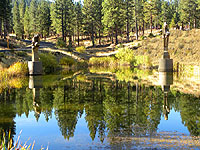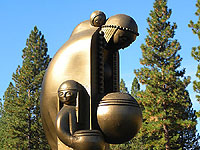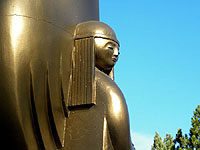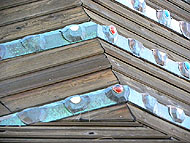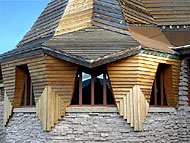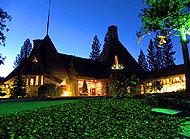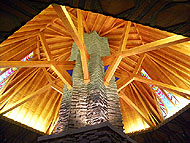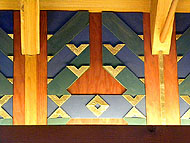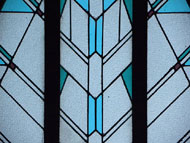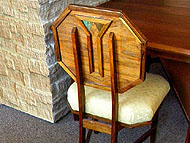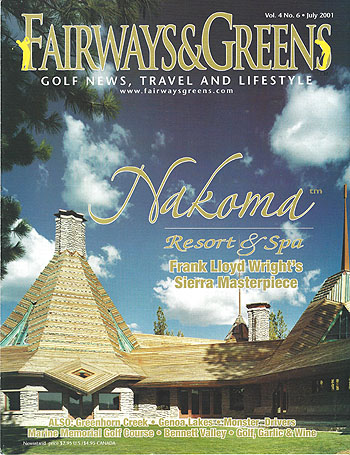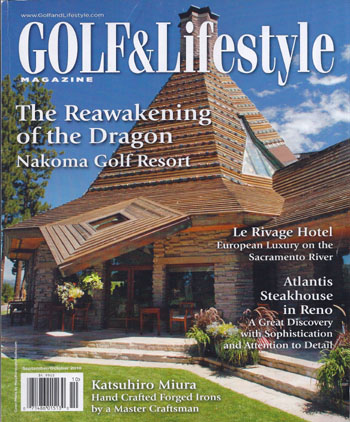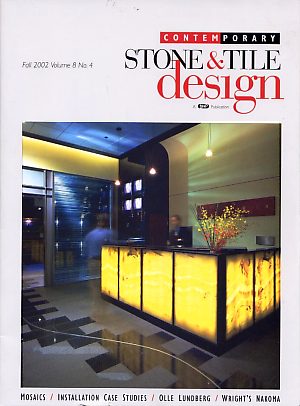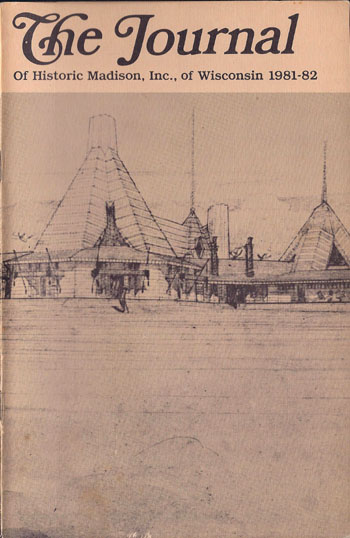
SUPPORT THE
WRIGHT LIBRARY
PROCEEDS FROM EVERY SALE GOES TO SUPPORT THE WRIGHT LIBRARY.
CLICK TO ORDER.
WE PROUDLY SUPPORT THE FRANK LLOYD WRIGHT FOUNDATION

WE PROUDLY SUPPORT THE FRANK LLOYD WRIGHT BUILDING CONSERVANCY
WE PROUDLY SUPPORT FALLINGWATER
AND THE WESTERN PENNSYLVANIA CONSERVANCY

Nakoma Country Club/Nakoma Memorial Gateway (1923/1924 - 2001)
"Frank Lloyd Wright's Nakoma Clubhouse & Sculptures." A comprehensive study of Wright’s Nakoma Clubhouse and the Nakoma and Nakomis Sculptures. In 1923, Frank Lloyd Wright presented drawings for a clubhouse to the Nakoma Country Club, which was adjacent to the Nakoma subdivision in Madison, Wisconsin. Nakoma was a Chippewa word that meant “I do as I promise.” A form of the name appeared in Longfellow’s poem “Song of Hiawatha,” 1856. The Wisconsin State Journal called the Wright clubhouse “the most unique building of its kind in America.” It would take nearly 75 years for this masterpiece to come to fruition. “Frank Lloyd Wright’s Nakoma Clubhouse and Sculptures, A Historic Perspective” sheds light on their inception, terra-cotta, bronze and granite sculptures, an apprentice prince, exhibitions and finally completion. Nearly 100 images. Now Available. Limited Edition. TO ORDER...
NAKOMA COUNTRY CLUB 1923 NAKOMA MEMORIAL GATEWAY 1924 NAKOMA & NAKOMIS 1930 NAKOMA & NAKOMIS 1950s
NAKOMA & NAKOMIS 1974 NAKOMA & NAKOMIS 1977 NAKOMA CLUBHOUSE MODEL 1988
NAKOMA CLUBHOUSE, NAKOMA & NAKOMIS 2001 FURNITURE & FABRIC 2001 NAKOMA & NAKOMIS 2004 NAKOMA & NAKOMIS 2011
NAKOMA CLUBHOUSE, NAKOMA & NAKOMIS 2012 NAKOMA CLUBHOUSE & SCULPTURES 2013 BIBLIOGRAPHY
FAIRWAY & GREENS GOLF & LIFESTYLE CHARLES MORGAN ADDITIOANAL WRIGHT STUDIES
Date: 1924
Title: Nakoma Sculpture Basin, Memorial Gateway Project, 1924 (FLLW #2405.12).
Description: In 1923 Wright was commissioned to design a clubhouse for the Nakoma Golf Club, Madison, Wisc. In 1924 he was commissioned to design the Memorial Gateway to the Nakoma subdivision, which at the time was on the outskirts of Madison. Wright’s plans were well received by the Madison Realty Company. Models of the Nakoma and Nakomis statues created by Wright were photographed on August 3, 1926 at Taliesin, Spring Green, for Franz A. Aust, by Melvin E. Diemer. But the project was rejected due to the cost. Wright refused to scale down the plans, and the Gateway project was abandoned.
“Nakomis, the Indian chief, was to be a statue of limestone 18 feet high, set in a circular pond 75 feet in diameter while opposite him was his squaw Nakoma set in her own reflecting pool of the same size. The road bed that gave access to the Nakoma Clubhouse beyond passed between the two figures. Nakomis is teaching his son to shoot the bow and arrow to the sun God, their forms are sharp and angular, dominant and masculine. Nakoma, with one child by her side and the other in a papoose on her back, is carrying a bowl of water. Their forms are curve linear, and gentle. Out of this bowl, which she is laboriously carrying, comes the water source for the fountain.” Brucce Brooks Pfeigffer, Frank Lloyd Wright Monogram 1924-1936, 1985.
Text: “Indian Memorial Nakoma Gateway. Frank Lloyd Wright Architect.” Text lower left: “ Nakoma Basin Stone Memorial to Nakoma ‘Woman’.“ Text lower right: “Nakomis Water-Plateau Stone Memorial To Nakomis ‘Warrior’.” Courtesy of the Frank Lloyd Wright Archives, Avery Library, Columbia University.
Size: 10 x 8 Color Photograph.
S#: 0164.20.1225
Date: 1924
Title: Nakoma Sculpture for the Nakoma Sculpture Basin, Memorial Gateway Project, 1924 (FLLW #2405.04).
Description: In 1923 Wright was commissioned to design a clubhouse for the Nakoma Golf Club, Madison, Wisc. In 1924 he was commissioned to design the Memorial Gateway to the Nakoma subdivision, which at the time was on the outskirts of Madison. Wright’s plans were well received by the Madison Realty Company. Models of the Nakoma and Nakomis statues created by Wright were photographed on August 3, 1926 at Taliesin, Spring Green, for Franz A. Aust, by Melvin E. Diemer. But the project was rejected due to the cost. Wright refused to scale down the plans, and the Gateway project was abandoned.
“Nakomis, the Indian chief, was to be a statue of limestone 18 feet high, set in a circular pond 75 feet in diameter while opposite him was his squaw Nakoma set in her own reflecting pool of the same size... Nakoma, with one child by her side and the other in a papoose on her back, is carrying a bowl of water. Their forms are curve linear, and gentle. Out of this bowl, which she is laboriously carrying, comes the water source for the fountain.” Brucce Brooks Pfeigffer, Frank Lloyd Wright Monogram 1924-1936, 1985.
Text: “Nakoma.” Courtesy of the Frank Lloyd Wright Archives, Avery Library, Columbia University.
Size: 10 x 8 Color Photograph.
S#: 0164.21.1225Date: 1924
Title: Nakomis Sculpture for the Nakoma Sculpture Basin, Memorial Gateway Project, 1924 (FLLW #2405.087).
Description: In 1923 Wright was commissioned to design a clubhouse for the Nakoma Golf Club, Madison, Wisc. In 1924 he was commissioned to design the Memorial Gateway to the Nakoma subdivision, which at the time was on the outskirts of Madison. Wright’s plans were well received by the Madison Realty Company. Models of the Nakoma and Nakomis statues created by Wright were photographed on August 3, 1926 at Taliesin, Spring Green, for Franz A. Aust, by Melvin E. Diemer. But the project was rejected due to the cost. Wright refused to scale down the plans, and the Gateway project was abandoned.
“Nakomis, the Indian chief, was to be a statue of limestone 18 feet high, set in a circular pond 75 feet in diameter while opposite him was his squaw Nakoma set in her own reflecting pool of the same size. The road bed that gave access to the Nakoma Clubhouse beyond passed between the two figures. Nakomis is teaching his son to shoot the bow and arrow to the sun God, their forms are sharp and angular, dominant and masculine.” Brucce Brooks Pfeigffer, Frank Lloyd Wright Monogram 1924-1936, 1985.
Courtesy of the Frank Lloyd Wright Archives, Avery Library, Columbia University.
Size: 10 x 8 Color Photograph.
S#: 0164.22.1225Date: 1926 Title: Nakoma and Nakomis models for the Memorial Gateway project, 1924.
Description: In 1923 Wright was commissioned to design a clubhouse for the Nakoma Golf Club, Madison, Wisc. In 1924 he was commissioned to design the Memorial Gateway to the Nakoma subdivision, which at the time was on the outskirts of Madison. Wright’s plans were well received by the Madison Realty Company. These models created by Wright were photographed on August 3, 1926 at Taliesin, Spring Green, Wisconsin for Franz A. Aust, by Melvin E. Diemer. But the project was rejected due to the cost. Wright refused to scale down the plans, and the Gateway project was abandoned. Courtesy of the Wisconsin Historical Society, WHS-101791. See our Wright study on the Nakoma Clubhouse & Sculptures.
Size: 5.75 x 10 B&W photograph.
S#: 0172.17.0613
Date: 1926 Title: Nakoma model for the Memorial Gateway project, 1924.
Description: Enlargement of Nakoma model from original 1926 image. In 1923 Wright was commissioned to design a clubhouse for the Nakoma Golf Club, Madison, Wisc. In 1924 he was commissioned to design the Memorial Gateway to the Nakoma subdivision, which at the time was on the outskirts of Madison. Wright’s plans were well received by the Madison Realty Company. These models created by Wright were photographed on August 3, 1926 at Taliesin, Spring Green, Wisconsin for Franz A. Aust, by Melvin E. Diemer. But the project was rejected due to the cost. Wright refused to scale down the plans, and the Gateway project was abandoned. Courtesy of the Wisconsin Historical Society, WHS-101791. See our Wright study on the Nakoma Clubhouse & Sculptures.
Size: 8 x 10 B&W photograph.
S#: 0172.18.0314
Date: 1926 Title: Nakomis model for the Memorial Gateway project, 1924.
Description: Enlargement of Nakomis model from original 1926 image. In 1923 Wright was commissioned to design a clubhouse for the Nakoma Golf Club, Madison, Wisc. In 1924 he was commissioned to design the Memorial Gateway to the Nakoma subdivision, which at the time was on the outskirts of Madison. Wright’s plans were well received by the Madison Realty Company. These models created by Wright were photographed on August 3, 1926 at Taliesin, Spring Green, Wisconsin for Franz A. Aust, by Melvin E. Diemer. But the project was rejected due to the cost. Wright refused to scale down the plans, and the Gateway project was abandoned. Courtesy of the Wisconsin Historical Society, WHS-101791. See our Wright study on the Nakoma Clubhouse & Sculptures.
Size: 8 x 10 B&W photograph.
S#: 0172.19.0314
Date: 1929 Title: Nakoma Model at Taliesin West, circa 1929.
Description: View 1, facing toward the left. In 1923 Wright was commissioned to design a clubhouse for the Nakoma Golf Club, Madison, Wisc. In 1924 he was commissioned to design the Memorial Gateway to the Nakoma subdivision, which at the time was on the outskirts of Madison. Wright’s plans were well received by the Madison Realty Company. Models were created by Wright and photographed on August 3, 1926 at Taliesin, Spring Green, Wisconsin for Franz A. Aust, by Melvin E. Diemer. Terra-cotta Nakoma and Nakomis sets were created in 1929-1930 by Charles L. Morgan. Frank Lloyd Wright’s project number for the Nakoma Sculptures was 2906, dating it as 1929. According to Oskar Munuz and Doug Volker, Taliesin West, this white plaster figure was most likely created for used in creating the 1929 terra cotta sets, not the original figure photographed in 1926. Note the left arm of father (right side) where it intersects with the son’s head. The arm in this model closer to the base of the neck then the back of the head, as in the 1926 photograph. Photographed in June, 2013 by Oskar Munuz, Taliesin West. See our Wright study on the Nakoma Clubhouse & Sculptures.
Size: 8 x 10 Color photograph.
S#: 0228.12.0314
Date: 1929 Title: Nakoma Model at Taliesin West, circa 1929.
Description: View 2, facing slightly toward the left. In 1923 Wright was commissioned to design a clubhouse for the Nakoma Golf Club, Madison, Wisc. In 1924 he was commissioned to design the Memorial Gateway to the Nakoma subdivision, which at the time was on the outskirts of Madison. Wright’s plans were well received by the Madison Realty Company. Models were created by Wright and photographed on August 3, 1926 at Taliesin, Spring Green, Wisconsin for Franz A. Aust, by Melvin E. Diemer. Terra-cotta Nakoma and Nakomis sets were created in 1929-1930 by Charles L. Morgan. Frank Lloyd Wright’s project number for the Nakoma Sculptures was 2906, dating it as 1929. According to Oskar Munuz and Doug Volker, Taliesin West, this white plaster figure was most likely created for used in creating the 1929 terra cotta sets, not the original figure photographed in 1926. Note the left arm of father (right side) where it intersects with the son’s head. The arm in this model closer to the base of the neck then the back of the head, as in the 1926 photograph. Photographed in June, 2013 by Oskar Munuz, Taliesin West. See our Wright study on the Nakoma Clubhouse & Sculptures.
Size: 8 x 10 Color photograph.
S#: 0228.13.0314
Date: 1929 Title: Nakoma Model at Taliesin West, circa 1929.
Description: View 3, facing forward. In 1923 Wright was commissioned to design a clubhouse for the Nakoma Golf Club, Madison, Wisc. In 1924 he was commissioned to design the Memorial Gateway to the Nakoma subdivision, which at the time was on the outskirts of Madison. Wright’s plans were well received by the Madison Realty Company. Models were created by Wright and photographed on August 3, 1926 at Taliesin, Spring Green, Wisconsin for Franz A. Aust, by Melvin E. Diemer. Terra-cotta Nakoma and Nakomis sets were created in 1929-1930 by Charles L. Morgan. Frank Lloyd Wright’s project number for the Nakoma Sculptures was 2906, dating it as 1929. According to Oskar Munuz and Doug Volker, Taliesin West, this white plaster figure was most likely created for used in creating the 1929 terra cotta sets, not the original figure photographed in 1926. Note the left arm of father (right side) where it intersects with the son’s head. The arm in this model closer to the base of the neck then the back of the head, as in the 1926 photograph. Photographed in June, 2013 by Oskar Munuz, Taliesin West. See our Wright study on the Nakoma Clubhouse & Sculptures.
Size: 8 x 10 Color photograph.
S#: 0228.14.0314
Date: 1929 Title: Nakoma Model at Taliesin West, circa 1929.
Description: View 4, facing right. In 1923 Wright was commissioned to design a clubhouse for the Nakoma Golf Club, Madison, Wisc. In 1924 he was commissioned to design the Memorial Gateway to the Nakoma subdivision, which at the time was on the outskirts of Madison. Wright’s plans were well received by the Madison Realty Company. Models were created by Wright and photographed on August 3, 1926 at Taliesin, Spring Green, Wisconsin for Franz A. Aust, by Melvin E. Diemer. Terra-cotta Nakoma and Nakomis sets were created in 1929-1930 by Charles L. Morgan. Frank Lloyd Wright’s project number for the Nakoma Sculptures was 2906, dating it as 1929. According to Oskar Munuz and Doug Volker, Taliesin West, this white plaster figure was most likely created for used in creating the 1929 terra cotta sets, not the original figure photographed in 1926. Note the left arm of father (right side) where it intersects with the son’s head. The arm in this model closer to the base of the neck then the back of the head, as in the 1926 photograph. Photographed in June, 2013 by Oskar Munuz, Taliesin West. See our Wright study on the Nakoma Clubhouse & Sculptures.
Size: 8 x 10 Color photograph.
S#: 0228.15.0314
Date: 1929 Title: Nakoma gilded Terra-cotta Sculpture 1929.
Description: Terra-cotta Nakoma and Nakomis sets were created in 1929-1930. Frank Lloyd Wright’s project number for the Nakoma Sculptures was 2906, dating it as 1929. Of interest is Charles L. Morgan’s involvement to create "a few black sets" of the Nakoma and Nakomis in 1930. (Frank Lloyd Wright and Madison, 1990, page 88). On March 3, 2008, this Nakoma Sculpture was sold at Treadway Gallery, Chicago. Unglazed terra-cotta, painted gold, impressed "Frank Lloyd Wright" inscription to base. It was given as a gift to the seller in August 1942. Height is 12.25". Price realized $2,800 plus 22% buyers premium. Acquired from and courtesy of Treadway Gallery. See our Wright study on the Nakoma Clubhouse & Sculptures.
Size: 8 x 10 Color photograph
S#: 0228.16.0314
Date: 1929 Title: Nakoma and Nakomis Terra-cotta Figures 1929.
Description: Terra-cotta Nakoma and Nakomis sets were created in 1929-1930. Frank Lloyd Wright’s project number for the Nakoma Sculptures was 2906, dating it as 1929. Of interest is Charles L. Morgan’s involvement to create "a few black sets" of the Nakoma and Nakomis in 1930. (Frank Lloyd Wright and Madison, 1990, page 88). On June 13, 2002, these sculpture were sold at Christie's Auction, "Important 20th Century Decorative arts Including Tiffany". Nakoma (left) 12.25 in. high, Nakomis (right) 18in. high, each impressed with Frank Lloyd Wright monogram. Price realized $5,975 plus buyers premium. Acquired from and courtesy of Christie's, New York. See our Wright study on the Nakoma Clubhouse & Sculptures.
Size: 8 x 10 Color photograph.
S#: 0228.17.0314
Date: 1929 Title: Nakoma and Nakomis plaster sculptures circa 1929.
Description: "Nakoma and Nakomis, depicting the curvilinear Nakoma with children, holding a vessel, and Nakomis standing, wearing a headdress and teaching his son to take the bow to the Sun God. Impressed box signature. Nakoma (left) 12" high, Nakomis (right) 16" high. Break bow and arrow." On December 7, 2013, this set sold at the Treadway Toomey auction. Price realized $2,750 plus 22% buyers premium. Acquired from and courtesy of Treadway Toomey Gallery. See our Wright study on the Nakoma Clubhouse & Sculptures.
Size: 8 x 10 Color photograph.
S#: 0228.18.0314
Date: 1929-30
Title: Nakoma Glazed Terra-cotta Sculpture, 1929-30.
Description: Black glazed terra-cotta Nakoma sculpture by Charles L. Morgan. Terra-cotta Nakoma and Nakomis sets were created in 1929-1930 by Charles L. Morgan from models created by Frank Lloyd Wright.
In 1923 Wright was commissioned to design a clubhouse for the Nakoma Golf Club, Madison, Wisc. In 1924 he was commissioned to design the Memorial Gateway to the Nakoma subdivision, which at the time was on the outskirts of Madison. Wright’s plans were well received by the Madison Realty Company. Wright designed the 18 foot Nakomis and a 16 foot Nakoma in 1923-24 for the Nakoma Memorial Gateway project. Models were created by Wright and were photographed on August 3, 1926 at Taliesin, Spring Green, Wisconsin. The project was rejected due to the cost. Wright refused to scale down the plans, and the Gateway project was abandoned.
The Powhatan Building was designed by architects Robert De Golyer and Charles L. Morgan, and completed in 1929. Morgan was responsible for the colorful mosaics in the lobbies and ballroom, as well as the colorful exterior terra-cotta panels featuring scenes with Native American references as well as other American Indian motifs finished with a black glaze.
With the completion of the Powhatan Building in 1929, Morgan’s association with Wright, and American Indian motifs and terra-cotta molds freshly on Morgan's mind, his involvement in the Nakoma and Nakomis sets was a natural fit. In a letter to Wright dated December 23, 1930, Morgan discussed finishing the chief and squaw statues in time for Christmas, "and after all these weeks I am having to keep at it all the time to get a few black sets..." It was possibly the same black glaze used on the Indian chiefs on the Powhatan Building.
Inscribed on the lower back side: “FLLW” within a square. After glazing, the impression of the square remains, but not the “FLLW”.
Size: 11.75" tall, 4" wide, 5.75" deep.”
ST#: 0228.43.1125Date: 1930 Title: Nakoma black glazed Terra-cotta Sculpture circa 1930.
Description: Terra-cotta Nakoma and Nakomis sets were created in 1929-1930. Frank Lloyd Wright’s project number for the Nakoma Sculptures was 2906, dating it as 1929. Of interest is Charles L. Morgan’s involvement to create "a few black sets" of the Nakoma and Nakomis in 1930. (Frank Lloyd Wright and Madison, 1990, page 88). This sculpture is in the Victoria & Albert Museum, London. Acquired from and courtesy of V&A Museum. See our Wright study on the Nakoma Clubhouse & Sculptures.
Size: 8 x 10 Color photograph.
S#: 0249.35.0314
Date: 1930 Title: Nakoma black glazed Terra-cotta Sculpture circa 1930.
Description: Terra-cotta Nakoma and Nakomis sets were created in 1929-1930. Frank Lloyd Wright’s project number for the Nakoma Sculptures was 2906, dating it as 1929. Of interest is Charles L. Morgan’s involvement to create "a few black sets" of the Nakoma and Nakomis in 1930. (Frank Lloyd Wright and Madison, 1990, page 88). On June 9, 1999, this sculpture were sold at Christie's Auction, "20th Century Decorative Arts". 12. in. high. Price realized $2,185 plus buyers premium. Acquired from and courtesy of Christie's, New York. See our Wright study on the Nakoma Clubhouse & Sculptures.
Size: 8 x 10 Color photograph.
S#: 0249.36.0314
Date: 1933
Title: Taliesin Fellowship Complex, 1933 (1932 - S.228).
Description: Perspective, Section and Plan for a dormitory room at the Taliesin Fellowship Complex. Perspective includes a drawing board and seat, hassock, bed closet and bookshelf. Of note is a model of the Nakoma sculpture atop the bookshelf, included in the Perspective and Section. Clipping pasted to verso: "A drawing by Frank Lloyd Wright of the layout of one of the boys' rooms in the dormitory at his new school, Taliesin Fellowship." Stamped on verso: "Mar 14 1933. N.E.A."
Size: Original 7.75 x 7.5 B&W photograph.
S#: 0370.17.0920
Date: 1955 Title: Nakomis Sculpture, gilded concrete, 1955.
Description: During the early 1950s, when he was 21, Prince Giovanni Del Drago became an apprentice at Taliesin. His interests were architecture and the arts. As an apprentice, he reproduced the Nakoma and Nakomis sculptures. "I remember working on them in Arizona during the winter of 1955-1956 under Mr. Wright’s guidance, casting them in concrete and gilding them in the studio of a sculptor in Phoenix," he recalled. Photographed in 2013 at Taliesin, Spring Green, by Tom Waddell. This Nakomis Sculpture stands 44 inches tall. Acquired from and courtesy of Tom Waddell, Spring Green, Wisc. See our Wright study on the Nakoma Clubhouse & Sculptures.
Size: 8 x 10 Color photograph.
S#: 1092.66.0314
Date: 1955 Title: Nakoma Sculpture, gilded concrete, 1955.
Description: During the early 1950s, when he was 21, Prince Giovanni Del Drago became an apprentice at Taliesin. His interests were architecture and the arts. As an apprentice, he reproduced the Nakoma and Nakomis sculptures. "I remember working on them in Arizona during the winter of 1955-1956 under Mr. Wright’s guidance, casting them in concrete and gilding them in the studio of a sculptor in Phoenix," he recalled. Photographed in 2013 at Taliesin, Spring Green, by Tom Waddell. This Nakoma Sculpture stands 36 inches tall. Acquired from and courtesy of Tom Waddell, Spring Green, Wisc. See our Wright study on the Nakoma Clubhouse & Sculptures.
Size: 8 x 10 Color photograph.
S#: 1092.67.0314
Apprentices working on the Nakoma Sculpture, Possibly Prince Giovanni Del Drago on the left. During the early 1950s, when he was 21, Prince Giovanni Del Drago became an apprentice at Taliesin. His interests were architecture and the arts. As an apprentice, he reproduced the Nakoma and Nakomis sculptures. "I remember working on them in Arizona during the winter of 1955-1956 under Mr. Wright’s guidance, casting them in concrete and gilding them in the studio of a sculptor in Phoenix," he recalled. Published in Frank Lloyd Wright Day in Chicago Date: 1955 Title: Schumacher/Heritage-Henredon Dining Room 1955.
Description: This is a copy of the photograph published in the "Schumacher’s Taliesin Line of Decorative Fabrics and Wallpaper," Schumacher/Wright, 1955, as an example of "Design No. 705" fabric and wallpaper. A similar design was used in 2001 at the Nakoma Clubhouse, Cleo, CA. The furniture was produced by Heritage-Henredon, designed by Frank Lloyd Wright. The buffet cabinet in the background is a combination of three small chests, No. 2002 (L), 2003 and 2001 (R). The table appears to be possibly a prototype of the dining room tables to come. The legs are correct, with the bullnose outer edge and carved patterned design. The round table top has the bullnose edge, but no design. To date, we have seen rectangular table tops as well as other furniture with the decorative design, but the round table tops, No. 2000 and 2001, are trimmed with copper moulding. The chairs do not appear to be designed by Wright, and were possibly used due to the lack of samples at the time. There is a note in House Beautiful, November, 1955, p.282 which might shed some light in explaining the discrepancies. "Much of this merchandise was not available for photograph as this issue went to press..." (Thanks to Peter Kelley, MassModern for his insight.) See additional information about the Nakoma Clubhouse.
Size: 10 x 8 B&W photograph.
S#: 1092.93.0416
Date: 1955 Title: Schumacher/Heritage-Henredon Dining Room 1955.
Description: This is a copy of the photograph published in House Beautiful, November, 1955, p.283. Drapes and wallpaper are "Design No. 705", "Schumacher’s Taliesin Line of Decorative Fabrics and Wallpaper," Schumacher/Wright, 1955, fabric and wallpaper. A similar design was used in 2001 at the Nakoma Clubhouse, Cleo, CA. The furniture was produced by Heritage-Henredon, designed by Frank Lloyd Wright. The buffet cabinet in the background is a combination of four small chests (L to R), No. 2003, 2002, 2003 and 2001. The shelf was an optional add-on. The table appears to be possibly a prototype of the dining room tables to come. The legs are correct, with the bullnose outer edge and carved patterned design. The round table top has the bullnose edge, but no design. To date, we have seen rectangular table tops as well as other furniture with the decorative design, but the round table tops, No. 2000 and 2001, are trimmed with copper moulding. The bench is No. 1904. There is a note in House Beautiful, November, 1955, p.282 which might shed some light in explaining the discrepancies. "Much of this merchandise was not available for photograph as this issue went to press..." (Thanks to Peter Kelley, MassModern for his insight.) See additional information about the Nakoma Clubhouse.
Size: 8 x 10 Color photograph.
S#: 1092.94.0416
Date: 1964
Title: William Wesley Peters standing in the Drafting Room at Taliesin Spring Green, 1964.
Description: The drafting room trusses are seen in the background. Clipping pasted to verso: "Heading the group of architects and other specialists who are carrying on the architectural practice of the late Frank Lloyd Wright, is William Wesley Peters, Wright's son-in-law, shown in the drafting room at the Hillside Home school at Taliesin." Of interest is the model of Frank Lloyd Wright’s Nakomis sculpture, designed for the Nakoma Memorial Gateway, 1924, an unrealized project, but realized in 1976 at the SC Johnson headquarters in Racine Wisconsin. The Taliesin Architects attempted to resurrect the Nakoma Clubhouse in 1967. The project was finally resurrected and completed in 2001. The Nakoma model could possibly be close to his drawing board for the 1967 attempt. Photographed by Ronald W. Nusbaum. Acquired from the archives of the Milwaukee Sentinel.
Size: Original 10 x 8 B&W photograph.
S#: 1596.66.1217Date: 1974
Title: Nakoma and Nakomis Sculpture, Bronze Sculptures, 1974.
Description: Frank Lloyd Wright designed the 18 foot Nakomis and 16 foot Nakoma in 1923-24 for the Nakoma Memorial Gateway project. Although the it was related to and was to be within eyesight of the Nakoma Country Club Clubhouse, it was a separate project. When the Nakoma Subdivision was developed in 1915 by the Madison Realty Company, Paul E. Stark became the sales agent. He was on the Board of Directors for both the Nakoma County Club and, in the early 1920s, the Madison Realty Company. There were also others who were members of both boards. Wright was commissioned by the Country Club for the Clubhouse, and by the developers of the subdivision for the Nakoma Memorial Gateway which included the Nakoma and Nakomis sculptures.
The Memorial Gateway was only one example of Wright’s appreciation of the American Indian heritage. John Lloyd Wright wrote, "Giannini from Italy painted American Indians in brilliant colors on the walls of Papa’s bedroom... Papa liked Indians!" (My Father Who is on Earth, 1946, page 34) Three American Indian murals were painted on walls in Frank Lloyd Wright’s Oak Park home in 1895.
Wright's plans were well received by the Madison Realty Company. Models created by Wright were photographed on August 3, 1926. But in a letter dated August 4, 1926, the project was rejected due to the cost. Wright refused to scale down the plans, and the Gateway project was abandoned.
According to Thomas Nelson Hubbard, he was given a set of Nakoma and Nakomis terra-cotta statues by his father, Willis W. Hubbard. Willis, an architect in the Chicago area, told him that he received the statues as a gift from the Otis Elevator Company.
To commemorate the fiftieth anniversary of the original design, Thomas Hubbard contacted the Frank Lloyd Wright Foundation and was granted a license to produce bronze sculptures in December 1973. Molds were created from the original terra-cotta sculptures created in 1929-30. The first bronze sets were produced by the Shidoni Foundry in Tesuque, New Mexico. The original list price was $1,650. The license specified that upon the production of 500 bronze sets, the molds would be destroyed. Original list price for pair $1,650.
Date: 1974
Title: Nakomis Sculpture, Bronze Reproduction, 1974.
Description: Frank Lloyd Wright designed the 18 foot Nakomis and 16 foot Nakoma in 1923-24 for the Nakoma Memorial Gateway project. Although the it was related to and was to be within eyesight of the Nakoma Country Club Clubhouse, it was a separate project. When the Nakoma Subdivision was developed in 1915 by the Madison Realty Company, Paul E. Stark became the sales agent. He was on the Board of Directors for both the Nakoma County Club and, in the early 1920s, the Madison Realty Company. There were also others who were members of both boards. Wright was commissioned by the Country Club for the Clubhouse, and by the developers of the subdivision for the Nakoma Memorial Gateway which included the Nakoma and Nakomis sculptures.
The Memorial Gateway was only one example of Wright’s appreciation of the American Indian heritage. John Lloyd Wright wrote, "Giannini from Italy painted American Indians in brilliant colors on the walls of Papa’s bedroom... Papa liked Indians!" (My Father Who is on Earth, 1946, page 34) Three American Indian murals were painted on walls in Frank Lloyd Wright’s Oak Park home in 1895.
Frank Lloyd Wright’s drawings for the project were comprehensive. They included birds-eye perspectives, plot plans, front, back and side views. The plan was comprised of two pools. The upper pool, "Nakomis Plateau," included the 18 foot rectangular Chieftain Nakomis which Wright described as "teaching his young son to take the bow to the Sun God." The lower pool, "Nakoma Basin," included the 16 foot circular Nakoma, which Wright described with "brimming bowl and children, symbolic of domestic virtue." Like Wright's earlier Dana House "Crannied Wall" and Midway Gardens figures, both Nakoma and Nakomis were characteristically abstract and geometric in shape.
Wright's plans were well received by the Madison Realty Company. Models created by Wright were photographed on August 3, 1926. But in a letter dated August 4, 1926, the project was rejected due to the cost. Wright refused to scale down the plans, and the Gateway project was abandoned.
According to Thomas Nelson Hubbard, he was given a set of Nakoma and Nakomis terra-cotta statues by his father, Willis W. Hubbard. Willis, an architect in the Chicago area, told him that he received the statues as a gift from the Otis Elevator Company.
To commemorate the fiftieth anniversary of the original design, Thomas Hubbard contacted the Frank Lloyd Wright Foundation and was granted a license to produce bronze sculptures in December 1973. Molds were created from the original terra-cotta sculptures created in 1929-30. The first bronze sets were produced by the Shidoni Foundry in Tesuque, New Mexico. The original list price was $1,650. The license specified that upon the production of 500 bronze sets, the molds would be destroyed.
Hubbard and The Frank Lloyd Wright Foundation also published the 12 page booklet "Indian Memorials". It included a short biography of Wright, examples of Wright's Dana House, Midway Gardens and Imperial Hotel sculptures, Wright's original drawings of the Nakoma and Nakomis, and photographs of the two new bronze sculptures. Inscribed on the lower left side: “FLLW /” within a square. Etched in the base: "The Frank Lloyd Wright Foundation © 1974. 91a/500." Original list price for pair $1,650.
Size: 17.5" tall, 3.5" wide, 7.5" deep, base is 5.25" deep.
S#: 1963.23.1118Date: 1974
Title: Nakoma Sculpture, Bronze Reproduction, 1974.
Description: Frank Lloyd Wright designed the 16 foot Nakoma in 1923-24 for the Nakoma Memorial Gateway project. Although the it was related to and was to be within eyesight of the Nakoma Country Club Clubhouse, it was a separate project. When the Nakoma Subdivision was developed in 1915 by the Madison Realty Company, Paul E. Stark became the sales agent. He was on the Board of Directors for both the Nakoma County Club and, in the early 1920s, the Madison Realty Company. Wright was commissioned by the Country Club for the Clubhouse, and by the developers of the subdivision for the Nakoma Memorial Gateway which included the Nakoma and Nakomis sculptures.
Frank Lloyd Wright’s drawings for the project were comprehensive. They included birds-eye perspectives, plot plans, front, back and side views. The plan was comprised of two pools. The upper pool, “Nakomis Plateau,” included the 18 foot rectangular Chieftain Nakomis which Wright described as “teaching his young son to take the bow to the Sun God.” The lower pool, “Nakoma Basin,” included the 16 foot circular Nakoma, which Wright described with “brimming bowl and children, symbolic of domestic virtue.” Like Wright’s earlier Dana House “Crannied Wall” and Midway Gardens figures, both Nakoma and Nakomis were characteristically abstract and geometric in shape.
Wright’s plans were well received by the Madison Realty Company. Models created by Wright were photographed on August 3, 1926. But in a letter dated August 4, 1926, the project was rejected due to the cost. Wright refused to scale down the plans, and the Gateway project was abandoned.
According to Thomas Nelson Hubbard, he was given a set of Nakoma and Nakomis terra-cotta statues by his father, Willis W. Hubbard. Willis, an architect in the Chicago area, told him that he received the statues as a gift from the Otis Elevator Company.
To commemorate the fiftieth anniversary of the original design, Thomas Hubbard contacted the Frank Lloyd Wright Foundation and was granted a license to produce bronze sculptures in December 1973. Molds were created from the original terra-cotta sculptures created in 1929-30. The first bronze sets were produced by the Shidoni Foundry in Tesuque, New Mexico. The original list price for the pair was $1,650. The license specified that upon the production of 500 bronze sets, the molds would be destroyed.
Hubbard and The Frank Lloyd Wright Foundation also published the 12 page booklet "Indian Memorials". It included a short biography of Wright, examples of Wright’s Dana House, Midway Gardens and Imperial Hotel sculptures, Wright’s original drawings of the Nakoma and Nakomis, and photographs of the two new bronze sculptures.
Inscribed on the lower back side: “FLLW /” within a square. Etched in the base: “© 1974. The Frank Lloyd Wright Foundation 3-B/500.” also, off to the side: “SF.” (Shidoni Foundry logo: Small “F” within a larger “S”.) Original list price for pair $1,650.
Size: 11.625" tall, 3.875" wide, 4.625" deep.”
S#: 1963.55.1124Date: 1974 Title: Nakomis Sculpture, Bronze 1974.
Description: Thomas Hubbard contacted the Frank Lloyd Wright Foundation and was granted a license to produce bronze sculptures in December 1973. The first bronze sets were produced in 1974 by the Shidoni Foundry in Tesuque, New Mexico. The original list price was $1,650 per set. On September 29, 2007, this sculpture were sold at Altermann Galleries, Sante Fe, NM. 18 in. high. Provenance: The Estate of the native American artist RC Gorman. Price realized $2,180 plus buyers premium. Acquired from and courtesy of Altermann Galleries, Sante Fe, NM. See our Wright study on the Nakoma Clubhouse & Sculptures.
Size: 8 x 10 Color photograph.
S#: 1963.14.0314
Date: 1974 Title: Nakoma Sculpture, Bronze 1974.
Description: Thomas Hubbard contacted the Frank Lloyd Wright Foundation and was granted a license to produce bronze sculptures in December 1973. The first bronze sets were produced in 1974 by the Shidoni Foundry in Tesuque, New Mexico. The original list price was $1,650 per set. On September 29, 2007, this sculpture were sold at Altermann Galleries, Sante Fe, NM. 12 in. high. Provenance: The Estate of the native American artist RC Gorman. Price realized $2,160 plus buyers premium. Acquired from and courtesy of Altermann Galleries, Sante Fe, NM. See our Wright study on the Nakoma Clubhouse & Sculptures.
Size: 8 x 10 Color photograph.
S#: 1963.15.0314
Date: 1974 Title: Nakoma, Nakomis, Winnebago Indian Memorials: Two Sculptures by Frank Lloyd Wright, 1924; Bronze Edition, 1974.
Author: Frank Lloyd Wright Foundation, Hubbard Associates
Description: Pamphlet includes a short biography on Wright, examples of Wright's Dana House, Midway Gardens and Imperial Hotel sculptures, Wright's original drawings of the Nakoma and Nakomis, and photographs of the two new bronze sculptures. On Wright's original drawing of the female squaw, the name Nakomis is clearly written twice, while on the drawing of the male chief there is no writing at all. This lead to the misconception that Nakoma was the Indian chief. (First Edition) (Sweeney 1942) See our Wright study on the Nakoma Clubhouse & Sculptures.
Size: 8 x 9"
Pages: Pp 12
ST#: 1942.00.1004
Date: 1974 Title: Related Item: Nakoma-Nakomis, Winnebago Indian Memorials: Two Sculptures by Frank Lloyd Wright 1924
Author: Frank Lloyd Wright Foundation, Hubbard Associates
Description: Small Poster or Card announcing the exhibit or sale of the two sculptures. See our Wright study on the Nakoma Clubhouse & Sculptures.
Size: 5.5 x 8.5
Pages: Pp 1
ST#: 1942.01.1201
Date: 2001
Title: Nakoma Resort & Spa Executive Desk Compass 2001.
Description: Etched on top: "Nakoma Resort & Spa, 1924-2001." Label on bottom: "Compass - Executive Desk $34.00. GNRWI380. Label on compass: "Made in Taiwan, Republic of China." The Nakoma Clubhouse was designed by Frank Lloyd Wright in1923 but never executed. The Wisconsin State Journal called the Wright clubhouse "the most unique building of its kind in America." It would take nearly 75 years for this masterpiece to come to fruition. Resurrected by the Taliesin Architects and the Garners, it was finally built in 2001. Original list price $34.00.
Size: 3.4 x 3.4 x1".
ST#: 2001.59.0415
2001 Nakoma Clubhouse Furniture and Fabric. During the beginning of June, 2015, we were notified that the Nakoma Golf Resort in Clio, California, was retiring and selling off the original furniture designed by John Rattenbury and the Taliesin Architects in 2001. Like the collaboration between Frank Lloyd Wright and George Niedecken during the beginning of the nineteenth century, Rattenburg also worked with Wright. John Rattenbury became a member of the Taliesin Fellowship in 1950, worked closely with Frank Lloyd Wright for nearly a decade. He worked on 60 of Wrights projects, including the Guggenheim Museum, the Gammage Auditorium and the Marin County Civic Center.
In 1959, Frank Lloyd Wright designed the Lykes Residence, his last residential work. As John Rattenbury describes it, "After studying the topographic map, Wright set it aside for a while and worked on other projects. He always allowed an idea to germinate before committing to it to paper. The next morning he quickly sketched a plan on the map... With a panoramic view in mind, and considering the shape of the natural plateau, he drew two overlapping circles... After a while, Wright got up from his desk and walked out of the studio. He never returned. The next day he was in the hospital with an intestinal problem..." A Living Architecture, Rattenbury, 2000, p.247-250. Working drawings were completed in 1966 by Rattenbury, who had worked closely with Mr. Wright on the initial plans and supervised the construction of the home. He designed the furniture and built-ins, adapted from the original plans created by Wright before his death.... Continue...Date: 2001 Title: Schumacher Fabric.
Description: The Nakoma chairs were upholstered in Schumacher’s "Imperial Triangle," teal, beige (rose) and ivory. It was first manufactured in 1986, and is reminiscent of "Design No. 705," Schumacher/ Wright, 1955. In 1955, Schumacher, in collaboration with Frank Lloyd Wright, produced "Schumacher’s Taliesin Line of Decorative Fabrics and Wallpaper" sample book. Design No. 705 Fabric Samples included Champagne, Willow Green, Gold, Pink, Turquoise, Granite and Tan. Matching wallpaper was available. In 1987, Schumacher, working with the Frank Lloyd Wright foundation, produced "Frank Lloyd Wright, A collection of Wallcoverings, Companion Fabrics and Borders" sample book. Colors included Taupe (warm beige), Pewter, Seafoam (ivory with light green triangles), Tan and Copper. Although there was matching fabric and borders, the design was different. Photographs of "Liberty Weave" appeared in the earlier "Frank Lloyd Wright: Schumacher" 1886, there were no fabric samples of it in 1987. Three bolts of fabric, 56" wide, teal, beige (rose) and ivory. See additional photographs...
ST#: 2001.68.0316 (25-27)
Date: 2001 Title: Nakoma Clubhouse Barrel Chair, 2001.
Description: "What we need today is that art shall have a new direction and artists consider the possibilities of an easy chair or the fireplace quite as important as the house itself or the picture on its walls, to the end that everything may contribute to easy utility and quiet beauty to the end, for it is not in itself that a thing is chiefly beautiful but in its relationships." — Frank Lloyd Wright, "Art in the Home." Arts for America, June, 1898, p.581. Frank Lloyd Wright first designed the barrel chair for the Darwin Martin Residence (1904). In 1905, he designed a barrel chair for the Frank L. Smith Bank. Slight modifications were made to the Martin design for the H. F. Johnson Jr. Residence, Wingspread (1937). He liked the design so much that when the order was placed for Johnson, he ordered a dozen for Taliesin. Constructed of solid wood and plywood, the design of the Nakoma barrel chairs utilizes five sides of the octagon. Chairs were upholstered in Schumacher’s "Imperial Triangle," teal, beige and ivory. It was first manufactured in 1986, and is reminiscent of "Design No. 705," Schumacher/ Wright, 1955. Chairs were also upholstered in Liberty Weave, Schumacher Series 89690 (1986) and burgundy vinyl. Four barrel chairs, two in beige, two in vinyl. See additional photographs...
Size: 27.5" wide x 27.5" deep x 28.5" high.
ST#: 2001.68.0316 (1-4)
Date: 2001 Title: Nakoma Clubhouse Dining Room Chair, 2001.
Description: Constructed of solid wood and plywood, Chairs repeat the octagon footprint of the Nakoma Clubhouse "Wigwam." The shape of the wigwam’s clerestory art glass windows is inverted and incorporated into the design on the back of the chairs, and are accented with patinated copper triangles. Chairs were upholstered in Schumacher’s "Imperial Triangle," teal, beige and ivory. It was first manufactured in 1986, and is reminiscent of "Design No. 705," Schumacher/Wright, 1955. Fourteen chairs, eight ivory, three in beige, three in teal. See additional photographs...
Size: 21" wide x 21" deep x 40" high.
ST#: 2001.68.0316 (5-18)
Date: 2001 Title: Nakoma Clubhouse Large Dining Room Table, 2001.
Description: Constructed of solid wood and plywood. The Nakoma table legs are not just legs, but a design that masters space. Tables are very functional. Place dining room table end to end, and you have an eight, twelve or sixteen foot table. See additional photographs...
Size: 42" wide x 42" deep x 30" high.
ST#: 2001.68.0316 (19)
Date: 2001 Title: Nakoma Clubhouse Medium Table, 2001.
Description: Constructed of solid wood and plywood. The Nakoma table legs are not just legs, but a design that masters space. See additional photographs...
Size: 30" wide x 30" deep x 30" high.
ST#: 2001.68.0316 (20)
Date: 2001 Title: Nakoma Clubhouse Small End Table, 2001.
Description: Constructed of solid wood and plywood. The Nakoma table legs are not just legs, but a design that masters space. See additional photographs...
Size: 22.5" wide x 22.5" deep x 25" high.
ST#: 2001.68.0316 (21)
Date: 2001 Title: Nakoma Clubhouse Plant Stand, 2001.
Description: Constructed of solid wood and plywood, the plant stand repeats the octagon footprint of the Nakoma Clubhouse "Wigwam." See additional photographs...
Size: 15" wide x 15" deep x 42" high.
ST#: 2001.68.0316 (22)
Date: 2001 Title: Nakoma Clubhouse Dining Room Carpet, 2001.
Description: Custom hand-knotted carpets from China surrounded the massive fireplace in the main "Wigwam" Dining Room. The carpet design was adapted by Rattenbury from Frank Lloyd Wright’s original plans. Gold, green, red and light blue. Two pieces. See additional photographs...
Size: Four feet wide by almost fifteen feet long.
ST#: 2001.68.0316 (23-24)
Date: 2002 Title: Nakoma Clubhouse Dining Room 2002.
Description: Designed by Frank Lloyd Wright in 1923, the Nakoma Clubhouse was not completed until May 2001. Wright’s plans were adapted by the Taliesin Architects, headed by lead architect Arnold Roy. At the center of Wright's design is the octagonal "Wigwam Room" and the majestic stone "Campfire" incorporating two rotated squares. Surrounding the room above the walls on all eight sides of the interior is a 17-foot high intricate Indian-motif frieze accented by art glass clerestory windows. Photographed by Mary E. Nichols. Published in the November 2002 issue of Architectural Digest. Acquired from and courtesy of Architectural Digest.
Size: 8 x 10 Color photograph.
ST#: 2002.03.0314
Date: 2002 Title: Nakoma Resort and Spa at Gold Mountain (Circa 2002).
Description: Informational brochure pertain to the new resort. "At the age of 57, Wright designed Nakoma clubhouse at the request of the Nakoma Country Club’s members. It was to be located in Madison, Wisconsin but never came to fruition. Nakoma was described the Club’s membership as having ‘originality and dignity and a feeling of a truly outdoor country club that should encourage a spirit of democracy and good fellowship among the membership.’ " Includes twelve photographs and a 3.75 x 8.75 loose Reply Card. See our Wright study on the Nakoma Clubhouse & Sculptures.
Size: 4 x 9.
Pages: Pp 12
ST#: 2002.99.0711
Date: 2004
Title: Nakoma and Nakomis
Artist: Frank Lloyd Wright
Description: Nakoma Sculpture Reproduction (On the left), Circa 2004. "Originally designed by Frank Lloyd Wright in 1923-1924 for the Nakoma Country Club in Madison, Wisconsin, to be 16 feet tall. The Nakoma sculpture is a curvilinear design, symbolic of the earth and Mother Nature as well as domestic virtue. Her back is a continuous circle, with a round head and she holds a round bowl. Nakoma also carries a papoose and has a child at her side. Produced by Nichols Bros. Stoneworks, Woodinville, Washington. Authenticated by the Frank Lloyd Wright Foundation. Cream Reconstituted Stone. 70 pounds. Gift from Paul Diederichs.
Nakomis Sculpture Reproduction (On the right), Circa 2004. "Originally designed by Frank Lloyd Wright in 1923-1924 for the Nakoma Country Club in Madison, Wisconsin, to be 18 feet tall. The Native American warrior, Nakomis, is a rectilinear design – Proud, angular and striking. With a commanding, fatherly presence he teaches his son to shoot with a bow and arrow." Produced by Nichols Bros. Stoneworks, Woodinville, Washington. Authenticated by the Frank Lloyd Wright Foundation. Cream Reconstituted Stone. 99 pounds. Gift from Paul Diederichs. See our Wright study on the Nakoma Clubhouse & Sculptures.
Size: Nakoma: 24" high. Nakomis 36" high.
ST#: 2004.61.0605, 2004.62.0605
Date: 2011
Title: Nakomis Sculpture Reproduction, HF Coors 2011.
Description: HF Coors Company was founded in 1925 by Herman Franklin Coors, son of the renowned brewer. In 2003, it was acquired by Catalina China, Inc. of Tucson, Arizona. Near the beginning of 2011, HF Coors was licensed by the Frank Lloyd Wright Foundation to create a dinnerware collection featuring the "Whirling Arrow" pattern. The license expanded to include the ceramic Nakoma and Nakomis. Molds were created from an original 1974 Hubbard set. The size reduction is due to shrinkage during the drying process. Both are slate gray.
Size: Nakoma stands 10 1/2", and the base is 2.5 x 2.75. Nakomis stands 15 1/2" and the base is 3.25 x 5.
ST#: 2011.25.0819Date: 2011
Title: Nakoma Sculpture Reproduction, HF Coors 2011.
Description: HF Coors Company was founded in 1925 by Herman Franklin Coors, son of the renowned brewer. In 2003, it was acquired by Catalina China, Inc. of Tucson, Arizona. Near the beginning of 2011, HF Coors was licensed by the Frank Lloyd Wright Foundation to create a dinnerware collection featuring the "Whirling Arrow" pattern. The license expanded to include the ceramic Nakoma and Nakomis. Molds were created from an original 1974 Hubbard set. The size reduction is due to shrinkage during the drying process. Both are slate gray.
Size: Nakoma stands 10 1/2", and Nakomis (not shown) 15 1/2".
ST#: 2011.21.0318Date: 2013 Title: Frank Lloyd Wright’s Nakoma Clubhouse and Sculptures (Published by Milbourn Publishing Co., Edmonds, WA)
Author: Steiner, Douglas M.
Description: A comprehensive study of Wright’s Nakoma Clubhouse and the Nakoma and Nakomis Sculptures. In 1923, Frank Lloyd Wright presented drawings for a clubhouse to the Nakoma Country Club, which was adjacent to the Nakoma subdivision in Madison, Wisconsin. Nakoma was a Chippewa word that meant "I do as I promise." The Wisconsin State Journal called the Wright clubhouse "the most unique building of its kind in America." It would take nearly 75 years for this masterpiece to come to fruition. "Frank Lloyd Wright’s Nakoma Clubhouse and Sculptures, A Historic Perspective" sheds light on their inception, terra-cotta, bronze and granite sculptures, an apprentice prince, exhibitions and finally completion. Nearly 100 images. (First Edition) To Order.
Size: 11 x 8.5
Pages: Pp 60
ST#: 2013.06.0414
Date: 2016 Title: Frank Lloyd Wright’s Nakoma Clubhouse and Sculptures (Published by Milbourn Publishing Co., Edmonds, WA) (First Edition, Second Printing)
Author: Steiner, Douglas M.
Description: A comprehensive study of Wright’s Nakoma Clubhouse and the Nakoma and Nakomis Sculptures. In 1923, Frank Lloyd Wright presented drawings for a clubhouse to the Nakoma Country Club, which was adjacent to the Nakoma subdivision in Madison, Wisconsin. Nakoma was a Chippewa word that meant "I do as I promise." The Wisconsin State Journal called the Wright clubhouse "the most unique building of its kind in America." It would take nearly 75 years for this masterpiece to come to fruition. "Frank Lloyd Wright’s Nakoma Clubhouse and Sculptures, A Historic Perspective" sheds light on their inception, terra-cotta, bronze and granite sculptures, an apprentice prince, exhibitions and finally completion. Nearly 100 images. (First Edition, Second Printing) To Order.
Size: 11 x 8.5
Pages: Pp 60
ST#: 2016.04.0816
Date: 2018
Title: Nakomis Sculpture Reproduction, Frank Lloyd Wright Foundation 2018.
Description: Frank Lloyd Wright Foundation celebrates Nakoma and Nakomis. Foundation Description: "Designed for Madison, WI, 1923. Built at the Nakoma Resort in Clio, CA 2001. The American Indian tipi inspired the design of the Nakoma Golf Club was originally created by Wright in 1923 for a country club that was planned on Winnebago tribal ceremonial campgrounds in Wisconsin. When it was actually constructed after Wright’s death in 2001 by the Taliesin Architects, it was for a different client in Northern California. Two sculptural figures were to stand in large circular shallow basins of water at the entrance to the Nakoma Country Club in Madison, Wisconsin. The California sculptures were created at ninety percent of the original plan and height 16 and 11 1/2 feet respectively and stand in the entrance of the resort to welcome guests. The Native American warrior, Nakomis, is a rectilinear design - Proud, angular and striking. With a commanding, fatherly presence he teaches his son to shoot with a bow and arrow." Frank Lloyd Wright’s models of the Nakoma and Nakomis were first photographed in 1926 at Taliesin. In 1929, Charles L Morgan created terra-cotta models, unglazed, black glaze and gold. In 1955, Prince Giovanni Del Drago, a Taliesin apprentice, created two concrete models, 36 and 44 inches tall, painted gold, and can be found at Taliesin today. In 1974, Thomas Hubbard was licensed by the Foundation to create bronze sculptures, 12 and 17 1/2 inches tall. In 1976, S. C. Johnson commissioned Kotecki Monuments to carve full sized sculptures of granite, 12 and 18 feet, and are located at the S. C, Johnson Headquarters in Racine Wisconsin. In 2001, when the Nakoma Club House was finally built in Northern California, Nakoma and Nakomis sculptures were also created, 11 1/2 and 16 feet tall by Nichols Stoneworks, and are painted in gold. In 2004 Nichols was licensed to create 24 and 36 inch, 36 and 54 inch sets, and are still obtainable. In 2011, HF Coors created ceramic sets, 10 1/2 and 15 1/2 inches tall. In 2018, the Frank Lloyd Wright Foundation has created sets, 11 1/2 and 17 3/4 inches tall. Manufactured of cold cast resin, painted gold. For the complete story, order your copy of "Frank Lloyd Wright’s Nakoma Clubhouse and Sculptures," Today, by Douglas M. Steiner. Original list price $99.00.
Size: Nakomis: 7.5" Deep x 3.5" Wide x 17.75" Tall.
ST#: 2018.23.1019Date: 2018
Title: Nakoma Sculpture Reproduction, Frank Lloyd Wright Foundation 2018.
Description: Frank Lloyd Wright Foundation celebrates Nakoma and Nakomis. Foundation Description: "Designed for Madison, WI, 1923. Built at the Nakoma Resort in Clio, CA 2001. The American Indian tipi inspired the design of the Nakoma Golf Club was originally created by Wright in 1923 for a country club that was planned on Winnebago tribal ceremonial campgrounds in Wisconsin. When it was actually constructed after Wright’s death in 2001 by the Taliesin Architects, it was for a different client in Northern California. Two sculptural figures were to stand in large circular shallow basins of water at the entrance to the Nakoma Country Club in Madison, Wisconsin. The California sculptures were created at ninety percent of the original plan and height 16 and 11 1/2 feet respectively and stand in the entrance of the resort to welcome guests. The Native American warrior, Nakomis, is a rectilinear design - Proud, angular and striking. With a commanding, fatherly presence he teaches his son to shoot with a bow and arrow." Frank Lloyd Wright’s models of the Nakoma and Nakomis were first photographed in 1926 at Taliesin. In 1929, Charles L Morgan created terra-cotta models, unglazed, black glaze and gold. In 1955, Prince Giovanni Del Drago, a Taliesin apprentice, created two concrete models, 36 and 44 inches tall, painted gold, and can be found at Taliesin today. In 1974, Thomas Hubbard was licensed by the Foundation to create bronze sculptures, 12 and 17.5 inches tall. In 1976, S. C. Johnson commissioned Kotecki Monuments to carve full sized sculptures of granite, 12 and 18 feet, and are located at the S. C, Johnson Headquarters in Racine Wisconsin. In 2001, when the Nakoma Club House was finally built in Northern California, Nakoma and Nakomis sculptures were also created, 11 1/2 and 16 feet tall by Nichols Stoneworks, and are painted in gold. In 2004 Nichols was licensed to create 24 and 36 inch, 36 and 54 inch sets, and are still obtainable. In 2011, HF Coors created ceramic sets, 10 ½ and 15 ½ inches tall. In 2018, the Frank Lloyd Wright Foundation has created sets, 11 3/4 and 17 3/4 inches tall. Manufactured of cold cast resin, painted gold. For the complete story, order your copy of "Frank Lloyd Wright’s Nakoma Clubhouse and Sculptures," Today, by Douglas M. Steiner. Original list price $89.00.
Size: Nakoma: 4.75" Deep x 3" Wide x 11.75" Tall.
ST#: 2018.24.1019
Madison, Wisconsin, was as close to what Wright would call a home town. In 1878 when he was 11 years old his family settled in Madison. He lived there until 1887 when he moved to Oak Park. One of his earliest projects was remodeling Rocky Roost (1893), a cottage on Lake Mendota, owned by his boyhood friend Robert Lamp. That same year he designed the Lake Mendota and the Lake Monona Boathouses. Ten years later, in 1903, Robert Lamp called on Wright to design a home for him in Madison. Wright also designed the Gilmore Residence in 1908.
Near the turn of the century, Madison experienced remarkable growth. To meet the ever increasing housing demands, farms were platted for subdivisions, including Wingra Park in the early 1890’s, University Heights in 1893, Oakland Heights and Randall Park in 1896. By 1910, West Lawn, Highland Park and Edgewood Park were included. At first, home sales were slow due to insufficient transportation. But as automobile ownership increased, so did the sales of outlying lots.
The first lots in the Nakoma subdivision became available in 1915 for $325 to $700. Nakoma is a Chippewa word which means “I do as I promise” or “I keep my word.” A drive through the neighborhood would reveal streets named Chippewa, Hiawatha, Cherokee, Seneca, Yuma, Council Crest and, of course, Nakoma. As sales increased, the Nakoma Country Club was established on land adjacent to the subdivision, nestled on the shore of Lake Wingra. For inspiration and design ideas for their clubhouse, some members may have visited the River Forest Golf Club in Illinois, designed by Frank Lloyd Wright in 1898.
During 1923, while Frank Lloyd Wright was at Taliesin in Spring Green, Wisconsin, he was visited by members of the Nakoma Country Club. They asked him to visit their propertyand then commissioned him to design the clubhouse plans.
Preliminary drawings for the Clubhouse were presented to the Board of Directors near the end of 1923. Wright utilized an American Indian theme and designed the clubhouse to represent a cluster of wigwams.
In 1923, Frank Lloyd Wright designed four homes in California utilizing his textile-block system (right). One of the options Wright presented to Nakoma utilized his textile-block system. Wright’s estimated cost to complete the Clubhouse was $70,000. The initial drawings were enthusiastically embraced and Wright was given the go ahead to complete his drawings and present them to the club membership.
In August of the following year, Wright presented his drawings to the club members. The focal point of his design was a large pyramid-shaped room he labeled “Wigwam.” At the heart of the immense room was a centrally located fireplace he labeled “Campfire.” The plans were well received, and Wright was paid for his services, but his Nakoma Clubhouse was not built.
In 1929 the Nakoma Country Club began construction of their clubhouse designed by another architect at a significantly reduced cost. One can only speculate as to why Wright’s design was rejected. It could have been the economy. As it slowed, they may have adopted a more conservative budget. Alternatively, the Nakoma Country Club may have been concerned about their public image. The Nakoma subdivision was advertised as “an ideal place to raise a family.” From 1925 through 1928, Wright’s second wife Miriam Noel mercilessly tormented and hounded him publicly. Their relationship was quite tumultuous. Coupled with Wright’s financial difficulties, the family-friendly Nakoma Country Club may have wanted to avoid the adverse publicity.
Frank Lloyd Wright's original perspective for the Nakoma Country Club, 1923. Courtesy of the Frank Lloyd Wright Foundation. Frank Lloyd Wright's original perspective for the Nakoma Country Club, 1923. Courtesy of the Frank Lloyd Wright Foundation. Nakoma Golf Resort Clubhouse, Clio, California. Copyright Douglas M. Steiner, 2012.
Nakoma Clubhouse Floor Plan 1924. Designed by Frank Lloyd Wright. Courtesy of the Frank Lloyd Wright Foundation. Illustration adapted by Douglas M. Steiner, 2012.
Nakoma Clubhouse Floor Plan 2001. The architects at Taliesin used the floor plan and elevations from the original drawings, but adapted the interior spaces to accommodate the Resorts requirements. Courtesy of the Taliesin Architects. Illustration adapted by Douglas M. Steiner, 2012.
Although the Nakoma Memorial Gateway was related to and was to be within eyesight of the Nakoma Country Club Clubhouse, it was a separate project. When the Nakoma Subdivision was developed in 1915 by the Madison Realty Company, Paul E. Stark became the sales agent. He was on the Board of Directors for both the Nakoma County Club and, in the early 1920s, the Madison Realty Company. There were also others who were members of both boards. Wright was commissioned by the Country Club for the Clubhouse, and by the developers of the subdivision for Nakoma and Nakomis. Madison Reality took a number of steps to promote sales in the new Nakoma subdivision. They built a new school in 1917, spending $15,000, and set aside land for parks. Transportation to “outlying” subdivisions was lacking, so they created the first private bus line in Madison.
The Madison Realty Company determined to utilize the Nakoma theme and honor the American Indian. The Nakoma Memorial Gateway was planned for the intersection of Nakoma Road and Manitou Way.
The Memorial Gateway is only one example of Wright’s appreciation of the American Indian heritage. John Lloyd Wright wrote, “Giannini from Italy painted American Indians inbrilliant colors on the walls of Papa’s bedroom... Papa liked Indians!” (My Father Who is on Earth, 1946, page 34) Three American Indian murals were painted on walls in Frank Lloyd Wright’s Oak Park home in 1895.
Frank Lloyd Wright’s drawings for the project were comprehensive. They included birds-eye perspectives, plot plans, front, back and side views. The plan was comprised of two pools. The upper pool, “Nakomis Plateau,” included the 18 foot rectangular Chieftain Nakomis which Wright described as “teaching his young son to take the bow to the Sun God.” The lower pool, “Nakoma Basin,” included the 16 foot circular Nakoma, which Wright described with “brimming bowl and children, symbolic of domestic virtue.” Like Wright’s earlier Dana House “Crannied Wall” and Midway Gardens figures, both Nakoma and Nakomis were characteristically abstract and geometric in shape.
Wright’s plans were well received by the Madison Realty Company. Models created by Wright were photographed on August 3, 1926. But in a letter dated August 4, 1926, the project was rejected due to the cost. Wright refused to scale down the plans, and the Gateway project was abandoned.
Frank Lloyd Wright's original perspective for the Memorial Gateway to Nakoma, 1924. Courtesy of the Frank Lloyd Wright Foundation.
Terra-cotta Nakoma and Nakomis sets were created in 1929-1930. Frank Lloyd Wright’s project number for the Nakoma Sculptures was 2906, dating it as 1929. Wright’s original models were possibly used to create the mold for the terra-cotta sets. Of interest is Charles L. Morgan’s involvement to create “a few black sets” of the Nakoma and Nakomis in 1930. (FLW and Madison, 1990, page 88).
Not only an architect, Charles Leonard Morgan (1890-1947) had a reputation as an excellent artist. Frank Lloyd Wright was working on the National Life Insurance Company project in 1924-1925. Wright sought Morgan’s help in preparing a series of perspective drawings for the project.
Due to financial difficulties, Frank Lloyd Wright was incorporated in 1927. He wrote in An Autobiography that “many stories of this incorporation of myself appeared. An idea gained credence that my financial troubles were over. That I could now work with no financial harassments or restrictions...” "An Autobiography" (1932, page 294). Donald Johnson writes that Wright tried to establish a series of partnerships with architects in Chicago, New York, Phoenix and Los Angeles. "Frank Lloyd Wright Versus America" 1990, page 11. One of the “Associates,” as Wright called them, was Charles L. Morgan. Wright continued in his Autobiography, “Charlie Morgan came forward, as a volunteer, and interested others.”
In a letter to Morgan on December 12, 1929, Wright clarified the relationship. “I have never entered into any partnership agreement and probably never shall, being totally unfitted for that type of co-operation. I prefer ‘association’...” Wright details a fee schedule and concludes with, “All contracts should be made and plans too, in the name of ... More information...
Nakoma (left) and Nakomis (right). Terra-cotta Figures. 12.25 and 18 inches high. Courtesy of Christie's.
During the early 1950s, Prince Giovanni Del Drago became an apprentice at Taliesin. His family was one of the oldest and most illustrious in Italy, primarily achieved when his grandfather married the daughter of the Queen of Spain.
Del Drago’s father, Don Giovanni, immigrated to the United States in 1904 when he was 22 years old. At 27, he married Mrs. Josephine Schmid, the wealthy widow of the founder of the Lion Brewery. She was 23 years older than he was.Giovanni Del Drago was 21 when he became a Taliesin apprentice. His interests were architecture and the arts. As an apprentice, he reproduced the Nakoma and Nakomis sculptures. “I remember working on them in Arizona during the winter of 1955-1956 under Mr. Wright’s guidance, casting them in concrete and gilding them in the studio of a sculptor in Phoenix,” he recalled.
Today the sculptures can be found at Taliesin, Spring Green.
According to Thomas Nelson Hubbard, he was given a set of Nakoma and Nakomis terra-cotta statues by his father, Willis W. Hubbard. Willis, an architect in the Chicago area, told him that he received the statues as a gift from the Otis Elevator Company.
Born in February 1931, Thomas graduated from Yale in 1953. After serving in the Army, he worked for Rand McNally & Company for nine years. He then formed his own company, Hubbard Scientific, the largest manufacturer of raised relief maps in the United States. After selling the company in 1973, he formed Crystal Productions, producing and publishing educational art and science resource materials. He was a talented watercolor artist, specializing in landscape, fly fishing and wildlife scenes.
To commemorate the fiftieth anniversary of the original design, Thomas Hubbard contacted the Frank Lloyd Wright Foundation and was granted a license to produce bronze sculptures in December 1973. Molds were created from theoriginal terra-cotta sculptures created in 1929-30. The first bronze sets were produced by the Shidoni Foundry in Tesuque, New Mexico. The original list price was $1,650. The license specified that upon the production of 500 bronze sets, the molds would be destroyed.
Hubbard and The Frank Lloyd Wright Foundation also published the 12 page booklet "Indian Memorials". It included a short biography of Wright, examples of Wright’s Dana House, Midway Gardens and Imperial Hotel sculptures, Wright’s original drawings of the Nakoma and Nakomis, and photographs of the two new bronze sculptures.
Approximately 200 sets have been produced, and sets are still available from the Zaplin/Lampert Gallery, Sante Fe, New Mexico.
Although Thomas was involved in a hang gliding accident in 1975 that left him a paraplegic, it did not dampen his enthusiasm for life. He passed away in March 2011, at the age of nearly 80.
Wright's original drawing of the Indian Chief Nakomis. On Wright's original drawing of the female squaw, the name Nakomis is clearly written twice, while on the drawing of the male chief there is no writing at all. This lead to the misconception that Nakoma was the Indian chief. Published in "Indian Memorials", Hubbard, 1974, page 4. Courtesy of the Frank Lloyd Wright Foundation. Hubbard Bronze sculptures, first produced in 1974. Nakomis (left) 17 1/2" high. Nakoma (right) 12" high. Courtesy of the Zaplin/Lampert Gallery. Cover of the "Indian Memorials", published by Hubbard Associates and the Frank Lloyd Wright Foundation. It included a short biography on Wright, examples of Wright's Dana House, Midway Gardens and Imperial Hotel sculptures, Wright's original drawings of the Nakoma and Nakomis, and photographs of the two new bronze sculptures.
In July 1936, construction was set to start on the SC Johnson global headquarters. But third generation leader H. F. Johnson, Jr. wanted a new, more modern approach. Frank Lloyd Wright was commissioned to design the company’s new Administration Building in Racine, Wisconsin. Designed in 1936, the Administration Building was completed on April 22, 1939. Wright commented, “I believe this is one of the best built buildings, technically, anywhere in the world. And I regard it not only a thoroughly modern piece of work but more nearly exemplifying the ideal of an organic architecture than any other I have built.” Architects have called it the greatest contribution to business housing since the advent of the skyscraper. It is designed with rounded corners and dendriform columns. Forty-three miles of glass tubing allows soft natural light to illuminate the great room.
During the construction of the Administration Building, Johnson also commissioned Wright to design his expansive home Wingspread in 1937. Although apprehensive, he commissioned Wright again to design a new research and development building. The Research Tower was designed in 1944, construction began in 1947 and opening ceremonies were held on November 17, 1950.
In 1976, at the direction of H. F. Johnson, Jr., Nakoma and Nakomis sculptures were commissioned for installation on the headquarter grounds of SC Johnson. Under the direction of William Wesley Peters and Heloise Crista Swaback, they were carved by Italian sculptors Flaviano Cenderelli and Bruno Borgioli of Kotecki Monuments in Ohio. The granite was quarried in Cold Spring, Minnesota.
Edward Kotecki III recalls, “I was very apprehensive about the project. But my father Edward Kotecki Jr. was excited with the challenge. And besides, there were no other sculptors in the county with the capability to complete such a monumental project.” Life-size plaster marquettes were created by Fritz
Courtesy of S.C. Johnson.Carpenter in Racine. Each sculpture was constructed in two pieces. Once carving began, they discovered the specified granite was so hard and dense that it would be more difficult and time consuming than anticipated. It took two years and 6,000 man-hours to complete the pair of sculptures.
“Our sculptors were so skilled, that when Nakoma and Nakomis were assembled for the first time at SC Johnson’s headquarters, the fit was so perfect, it needed very little modification,” remembered Edward.
For the first time in more than 50 years, the full size sculptures were created as Wright had originally intended. The Nakoma sculpture is 12 feet tall and weighs 12 tons. The Nakomis sculpture is nearly 18 feet tall and weighs nearly 40 tons. Both were carved from charcoal gray Cold Spring, Minnesota granite, and adorn the courtyard of the SC Johnson Research Tower.
The sculptures were installed in 1979. “My father, Edward Kotecki Jr., as well as our sculptors have passed,” said Edward III. “Creating sculptures like these are a lost art.”
Sixty-five years after Frank Lloyd Wright designed the Nakoma Clubhouse, a three-dimensional model was commissioned by the Elvehjem Museum of Art in Madison, Wisconsin (presently the Chazen Museum of Art). The model was constructed for the 1988 exhibition "Frank Lloyd Wright and Madison: Eight Decades of Artistic and Social Interaction".
Bruce Severson restored a number of existing Wright models and created two new models for the exhibition. The two new models included the Lake Mendota Boathouse — built in 1893, demolished in 1926 — and the Nakoma Clubhouse, which was designed in 1923, but never built. “I was practicing architecture in Madison at the time, and moonlighting as a model builder,” said Severson. “The Museum approached me and asked if I would present a bid for the project. After winning the bid, I took a sabbatical from my practice to restore and build the models forthe exhibition. I have been building models ever since.
“Nakoma is an all wood model built at a scale of 1/8’ = 1’, based on plans provided by Taliesin,” Severson said. “I redrew it to the scale I was building and filled in missing information based on the drawings. The building consists of numerous sub-assemblies that are held together with hidden fasteners, a technique I used mainly to keep control of the rather complex interaction of the geometry and joinery.”15
The model was also included in "Frank Lloyd Wright Retrospective", a major Japanese exhibition that took place at four different locations in 1991.
The completion of these models led Severson to other Wright projects over the years, such as the restoration of Wright’s original Broadacre City for the 1995 exhibition Frank Lloyd Wright: Architect, at the Museum of Modern Art, New York.
Three dimensional model of the Frank Lloyd Wright design for the Nakoma Country Club. Courtesy of Bruce Severson and the Chazen Museum of Art.
Dariel and Peggy Garner. In the 1970’s, the Garners created a small computer software company for the banking industry. It grew from 1 office to 16 offices across the country. Tiring of the hectic schedule, they sold the company, retired and moved to a remote area of La Paz on Mexico’s Baja Peninsula. There they discovered that watercress grew naturally and plentifully in the area and were soon harvesting it for distribution to Southern California stores and restaurants. Their entrepreneurial spirit blossomed into a 6,000 acre farm pioneering gourmet baby and specialty vegetables, supplying niche-market produce to North America and the rest of the world.
Upon retiring a second time in the early 1990s, they setout in search of the ideal place to build their dream home. After exploring the country, they found it in the High Sierras on Gold Mountain in Northern California. They purchased 1,280 acres, two square miles, about an hour northwest of Reno and Lake Tahoe. Unwilling to retire, plans were made for a resort, golf course and subdivision. Of the 427 building sites, 27 sold within the first month. Two-acre wooded lots started at $70,000.
The Garners contacted the Frank Lloyd Wright Foundation and began working with the Taliesin Architects in 1995. During a planning meeting they were shown the original Nakoma clubhouse plans. “When they showed us Mr. Wright’s design for Nakoma, we fell in love with it,” said Peggy. They... More information...
Text by Douglas M. Steiner, Copyright 2012. All photographs courtesy of the Taliesin Architects.
Nakoma Clubhouse. Nakoma Clubhouse Furniture and Fabric. Road Trip. During the beginning of June, 2015, we were notified that the Nakoma Golf Resort in Clio, California, was retiring and selling off the original furniture designed by John Rattenbury and the Taliesin Architects in 2001. Like the collaboration between Frank Lloyd Wright and George Niedecken during the beginning of the nineteenth century, Rattenburg was an apprentice and worked closely with Wright. John Rattenbury became a member of the Taliesin Fellowship in 1950, worked with Frank Lloyd Wright for nearly a decade. He worked on 60 of Wrights projects, including the Guggenheim Museum, the Gammage Auditorium and the Marin County Civic Center.
In 1959, Frank Lloyd Wright designed the Lykes Residence, his last residential work. As John Rattenbury describes it, "Afterstudying the topographic map, Wright set it aside for a while and worked on other projects. He always allowed an idea to germinate before committing to it to paper. The next morning he quickly sketched a plan on the map... With a panoramic view in mind, and considering the shape of the natural plateau, he drew two overlapping circles... After a while, Wright got up from his desk and walked out of the studio. He never returned. The next day he was in the hospital with an intestinal problem..." A Living Architecture, Rattenbury, 2000, p.247-250. Working drawings were completed in 1966 by Rattenbury, who had worked closely with Mr. Wright on the initial plans and supervised the construction of the home. He designed the furniture and built-ins, adapted from the original plans created by Wright before his death.
A few notable projects he was ... Continue...
Photographs and text by Douglas M. Steiner, Copyright 2016.
Nichols Brothers Stoneworks was involved in creating the original Nakoma and Nakomis sculptures for the Nakoma Golf Resort in Northern California.
According to D. R. Hendel of Nichols Bros., they were contacted in 2001 to create a set for the Nakoma Golf Resort. Because a full sized set already existed at the SC Johnson Headquarters in Racine, Wisconsin, this set would be created at 90% of the original height, 11 1/2 and 16 feet tall. Sculptor Ivy Nichols created full size sculptures out of plaster. Rubber molds was formed around the plaster sets. Finally concrete was poured into the molds and left to dry for two weeks before the molds were removed. Nakoma and Nakomis were transported to California and placed on pedestals that were awaiting their arrival. Once installed, the set was painted gold, much like one of the 1929-30 terra-cotta sets and the 1955 Giovanni Del Drago set.
After successfully creating and installing the set at the Resort, they obtained a license from the Frank Lloyd Wright Foundation in 2004 to produce and sell sets in two different sizes. The smaller Nakoma and Nakomis set is 24” and 36” respectively, and the larger sets are 36” and 54”. Cast in reconstituted stone, the smaller set is available in cream, the larger sets in five different colors.
HF Coors Company was founded in 1925 by Herman Franklin Coors, son of the renowned brewer. In 2003, it was acquired by Catalina China, Inc. of Tucson, Arizona.
Near the beginning of 2011, HF Coors was licensed by the Frank Lloyd Wright Foundation to create a dinnerware collection featuring the “Whirling Arrow” pattern. The license expanded to include the ceramic Nakoma and Nakomis.
Molds were created from an original 1974 Hubbard set. The size reduction is due to shrinkage during the drying process. Nakoma stands 10 1/2”, and Nakomis 15 1/2”. Both are slate gray.
Entrance and the Nakoma Basin. Frank Lloyd Wright’s work never ceases to amaze and inspire me, even 53 years past his death. In October 2012, my wife and I had the opportunity to visit the Nakoma Golf Resort, located northwest of Reno, on the northern end of the Sierra-Nevada Mountain Range in California. One year earlier, my nephew Caleb Olsen, Golf Pro and General Manager at Nakoma, called, “You will never guess where I’m working.”
As we turned onto Bear Run Drive I had to smile. Very clever of the Taliesin Architects. Fallingwater, one of Wright’s most famous homes, is built over a stream called Bear Run. Another street is named Fallingwater. My first surprise was to glimpsewhat I had only visualized from Wright’s illustrations created nearly 90 years earlier. Just to the right of the drive were massive statues, placed in a pond, the closest I have seen to how Wright had originally envisioned them. My wife told me to settle down.
Wright’s original drawings for the Nakoma and Nakomis statues, known as the “Nakoma Memorial Gateway,” originally placed them in two separate pools. The upper pool, “Nakomis Plateau,” included the 18-foot rectangular chieftain Nakomis. The lower pool, “Nakoma Basin,” included the 16 -foot circular Nakoma. In deference to the full sized SC Johnson Headquarters’ 1976 statues, these were created at ninety percent of the original height: 16 and 11 1/2 feet respectively... More information...
Photographs and text by Douglas M. Steiner, Copyright 2012.
Nakoma Clubhouse Exterior. Frank Lloyd Wright’s ability to blend building with nature is not lost with his design of the Nakoma Clubhouse. As you approach, the Clubhouse blends, flows and grows from its site. When Wright presented his drawings for the clubhouse to the Nakoma Country Club members, Madison, Wisconsin, the Wisconsin State Journal called the clubhouse “the most unique building of its kind in America.” Ninety years later, those words are prophetic.
The original Nakoma subdivision, now part of Madison, was created in 1915. Developers gave it a theme honoring Native Americans. Nakoma is a Chippewa word meaning “I do as I promise.” Driving through the neighborhood would reveal streets named Chippewa, Hiawatha, Cherokee, Ottawa, Seneca, Yuma, Council Crest and Nakoma. Community meetings were called “councils.” Women’s groups set up “tribes.” As sales increased,the Nakoma Country Club was established on land adjacent to the subdivision.
Wright chose to embrace the American Indian theme and designed the Clubhouse to represent a cluster of wigwams. The focal point of his design was a large teepee shaped room he named “Wigwam.” At the heart of this immense room was a centrally located fireplace he labeled “Campfire.”
Native American symbols are prevalent in every aspect of the design. When taken as a whole, it dazzles the eye. Besides the many teepee shapes, of which there are five, other Native American symbols are prevalent. Early Native Americans would create patterns using the “chevron,” an inverted “V,” connecting them end to end. This pattern is present in many details of the Nakoma Clubhouse. Wright also added horizontal bands of copper to the teepees. They were decorated with... More information...
Photographs and text by Douglas M. Steiner, Copyright 2012.
Nakoma Clubhouse Interior. Entering the dining room is an exhilarating and inspiring experience. At the center of Wright’s design is the octagonal “Wigwam Room.” Above its walls, the massive roof reaches an enclosed interior height of 40 feet above a natural flagstone floor. At the center of the dining room is the majestic stone “Campfire” incorporating two rotated squares. The hearth opens on all four sides.
Surrounding the room above stone walls on all eight sides of the interior is a 17-foot high intricate Indian-motif frieze. The color scheme includes blue, green, gold and natural wood. It is accented by giant clerestory art glass windows.
Wright was a master at sculpting a simple sheet of plywood. In 1937 Wright designed an elaborate plywood mural forthe office of Edgar Kaufmann of Fallingwater. It was dismantled in 1955, and given to the Victoria and Albert Museum, London in 1973. Other wall designs include Midway Gardens (1913), the Imperial Hotel (1915) and homes like the Coonley Residence (1907) and Hollyhock House (1917).
The exposed beams create geometric patterns and bring to mind the drafting room truss structure at Taliesin. The craftsman were so skilled, it is hard to believe that the beams are not solid wood but steel beams encased in wood.
The immense clerestory art glass windows mimic the shape of the wigwam and chimney. They are nearly 10 feet wide and are 13 feet tall. The 7.5 foot high stone walls are dwarfed by the immensity of the wigwam. More information...
Photographs and text by Douglas M. Steiner, Copyright 2012.
Text by Douglas M. Steiner, Copyright 2012
"Frank Lloyd Wright's Nakoma Clubhouse & Sculptures." A comprehensive study of Wright’s Nakoma Clubhouse and the Nakoma and Nakomis Sculptures. In 1923, Frank Lloyd Wright presented drawings for a clubhouse to the Nakoma Country Club, which was adjacent to the Nakoma subdivision in Madison, Wisconsin. Nakoma was a Chippewa word that meant "I do as I promise." The Wisconsin State Journal called the Wright clubhouse "the most unique building of its kind in America." It would take nearly 75 years for this masterpiece to come to fruition. "Frank Lloyd Wright’s Nakoma Clubhouse and Sculptures, A Historic Perspective" sheds light on their inception, terra-cotta, bronze and granite sculptures, an apprentice prince, exhibitions and finally completion. Nearly 100 images. A limited edition.
TO ORDER...
Items related to Nakoma Clubhouse and Scupltures "Frank Lloyd Wright: Aus dem Lebenswerke eines Architekten", De Fries, 1926, Page 51. "Color Sketches: Spain, France, England", Morgan, 1927. "An Autobiography", Wright, 1932, Page 294. "In The Nature of Materials: 1887 - 1941, The Buildings of Frank Lloyd Wright", Hitchcock, 1942, Plates 267-268. "My Father Who is on Earth", Wright, 1946, Page 34. "Schumacher’s Taliesin Line of Decorative Fabrics and Wallpaper", 1955. "Nakoma, Nakomis, Winnebago Indian Memorials", Hubbard, 1974. "Frank Lloyd Wright Kelmscott Gallery", Elliot, 1981, Page 40. "Wright’s Nakoma Country Club: An Unrealized Madison Masterpiece", Hamilton, The Journal of Historic Madison, Volume VII: 1981-82, Pages 2-14. "Letters to Architects, Frank Lloyd Wright", Wright; Pfeiffer, 1984, Page 79-80. "The Wright Legend in Madison. A major exhibition about Frank Lloyd Wright", Gruber, On Wisconsin, December 1987, Pages 1, 6-7. "Frank Lloyd Wright and Madison: Eight Decades of Artistic and Social Interaction", Hamilton, 1990, Pages 77-88. "Frank Lloyd Wright Versus America, The 1930s", Johnson, 1990, Page 11. "Frank Lloyd Wright Retrospective", Mainichi Newspapers, 1991, Figures 157-158, 199. "Frank Lloyd Wright: A Biography", Secrest, 1992, Page 501. "Frank Lloyd Wright & The Book Arts", Hamilton, 1993, Page 88. "About Wright: An Album of Recollections by Those Who Knew Frank Lloyd Wright", Tafel, 1993, Page 94, 124. "Frank Lloyd Wright: Designs for American Landscape 1922-1932", Delong, 1996, Pages 65-67. "Frank Lloyd Wright, Louis Sullivan and the Skyscraper", Hoffmann, 1998, Page 61. "Frank Lloyd Wright - The Lost Years", Alofsin, 1998, Pages 280-294. "Frank Lloyd Wright’s Monona Terrace", Mollenhoff; Hamilton, 1999, Pages 74-76. "Treasures of Taliesin", Pfeiffer, 1999, Pages "Clubhouse Opens at Gold Mountain", Frank Lloyd Wright Quarterly, Summer 2001, Pages 28-29. "Nakoma. A Mountain Retreat Built around a Wrightian Dream", Hall, Architectural Digest, November 2002, Pages "Nakoma is Built. Taliesin Architects Adapts Wright’s", Taliesin Fellows Newsletter, October 15, 2002, Page 3. "Resurrecting Wright’s Vision", Adams, Stone & Tile Design, Fall 2002, Pages 62-66. "The Nakoma Neighborhood", Heggland, 2002 "The Nakomis and Nakoma Stautes", Owings, Frank Lloyd Wright Quarterly, Fall 2006, Pages 14-17, 20. “Taliesin Reconsidered. Burnishing the Treasure that is Frank Lloyd Wright’s Masterwork", Webb, Architectural Digest, May 2004, Pages 294-295. "Pedro E. Guerrero, A Photographer's Journey", Guerrero, 2007, page 60-61. "The Reawakening of the Dragon, Nakoma Golf Resort", Stewart, Golf & Lifestyle, Sept/Oct 2010, Pages 28-33. FAIRWAYS & GREENS Date: 2001
Title: Fairways & Greens - July 2001 (Offprint)
Author: Williams, Vic
Description: "Nakoma. Gold Mountain reveals the ‘Wright’ way to build a world-class Sierra resort. Frank Lloyd Wright was both a born-and-bread Midwesterner and a man of the world. Though he grew up on the relatively flat landscape of his native Wisconsin, he had an innate affinity for the geography and geometry of the American West – the acute, soaring angularity of its mountains, its almost unfathomable distances, its boundless lines of sight. It was as if he had the West in his blood even before he’d set foot on its soil..." Includes 10 photographs. Gift from Kathryn Smith. See our Wright Study. See our Wright study on the Nakoma Clubhouse & Sculptures.
Size: 8.5 x 11
Pages: Pp 8
ST#: 2001.69.0616GOLF & LIFESTYLE Date: 2010 Title: Golf & Lifestyle - September/October 2010 (Published by Golf & Lifestyle Magazine, LLC, Sacramento, CA)
Author: Stewart, Bobbi
Description: The Reawakening of the Dragon Nakoma Golf Resort. The beautiful and pristine land of Gold Mountain has been housing a magnificent sleeping giant for far to long. After over five years of upheaval and bankruptcy court, the Nakoma golf Resort has been sold, and the ‘reawakening’ of The Dragon Golf Course has begun... Nakoma... Golf Resort opened in 200, but the architectural concept was conceived by Frank Lloyd Wright in 1923. Mr. Wright designed the 23,000 square foot clubhouse for the planned Nakoma Golf Club located in Wisconsin..." Includes eight photographs by Mary Burroughs. Original cover price $4.99.
Size: 9 x 10.9
Pages: Pp Cover 8 28-33
ST#: 2010.18.0314
STONE & TILE DESIGN Date: 2002 Title: Stone & Tile Design - Fall 2002
Author: Adams, Jennifer
Description: Resurrecting Wright’s Vision. Original 1920s design for the Nakoma Country Club built in Northern California.
Size:
Pages: Pp 62-66
ST#: 2002.33.1002
JOURNAL OF HISTORIC MADISON Date: 1982 Title: The Journal of Historic Madison, Inc., of Wisconsin, Volume VII: 1981-82 (Published annually by Historic Madison, Inc., Wisconsin)
Author: Hamilton, Mary Jane
Description: "Wright’s Nakoma Country Club: An Unrealized Madison Masterpiece. ...One of the most interesting of these unbuilt designs is the 1923-24 plan for the Nakoma County Club.... The use in the Nakoma project of non-rectangular rooms, pointed, tepee-like roof forms, textile block construction, brilliant exterior color, and gravity heat offers the basis for several comparisons with earlier Wright designs..." Includes six photographs and illustrations. Original cover price $3.50.
Size: 5.5 x 8.5
Pages: Pp Cover, 2-14
ST#: 1982.40.1012
Additional Wright Studies SEE ADDITIONAL WRIGHT STUDIES Frank Lloyd Wright's First Published Article (1898) Photographic Chronology of Frank Lloyd Wright Portraits
"Frank Lloyd Wright's Nakoma Clubhouse & Sculptures." A comprehensive study of Wright’s Nakoma Clubhouse and the Nakoma and Nakomis Sculptures. Now Available. Limited Edition. More information.
HOME ARTIFACTS AUDIO BOOKS PERIODICALS PHOTOS POSTCARDS POSTERS STAMPS STUDIES ASSISTING ABOUT SLIDE SHOW To donate or pass on information, comments or questions:
steinerag@msn.com
©Copyright Douglas M. Steiner, 2001, 2026
